
gallery
Pictures from my work as a forestry consultant around the Scottish Highlands, plus some other images, some related, some not.

A view of the National Forest Estate in Foyers
This is Foyers, where I am based. The woodland in the background is not one that I manage. It is part of the National Forest Estate. In other words, it is owner by the citizens of the UK and managed by Forest Enterprise. Here in Scotland, the Government is presently consulting on the future of a devolved state forestry. You are encouraged to read this and make your views known.
Details here http://www.gov.scot/Publications/2016/08/1075
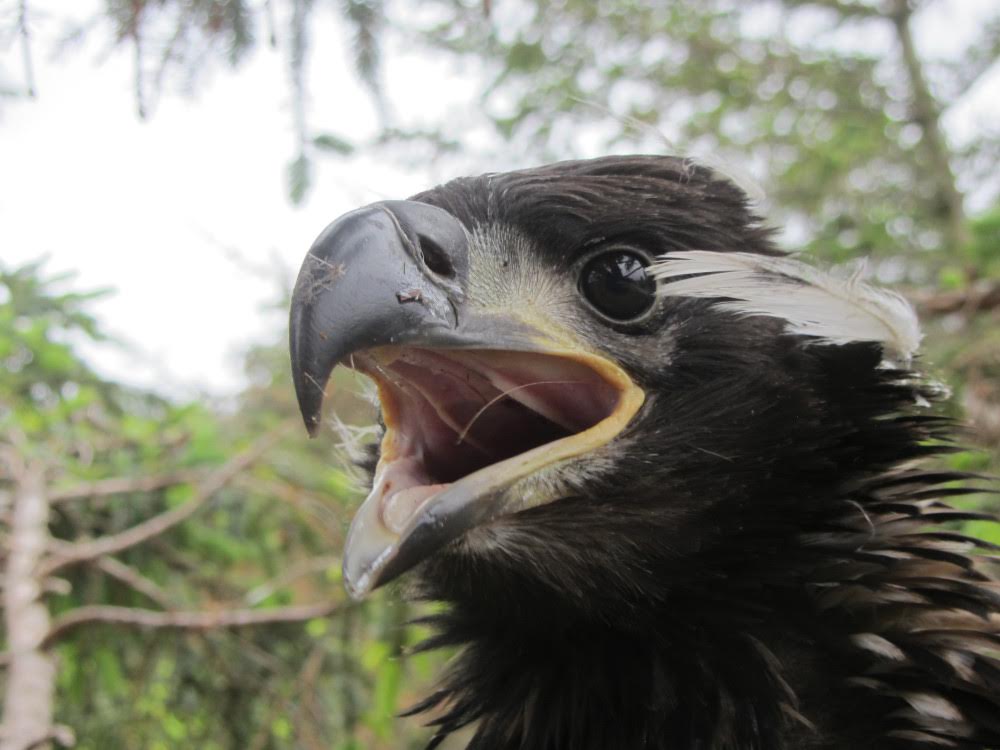
A young white-tailed sea eagle
I was fortunate enough to be managing a forest that contained a nesting pair of white-tailed sea eagles. These fantastic birds are slowly spreading around the Scottish coastline. Being a protected species, I had to be careful that they suffered no ill-effect from some future timber harvesting works that were being planned. At the time, I did not know whether the adult birds had successfully produced offspring so, in cooperation with RSPB Scotland and Scottish Natural Heritage, I arranged for Justin Grant and Abigail Rhodes to climb the tree containing the nest and check the health of any chicks that were inside. They were met with this young fellow!
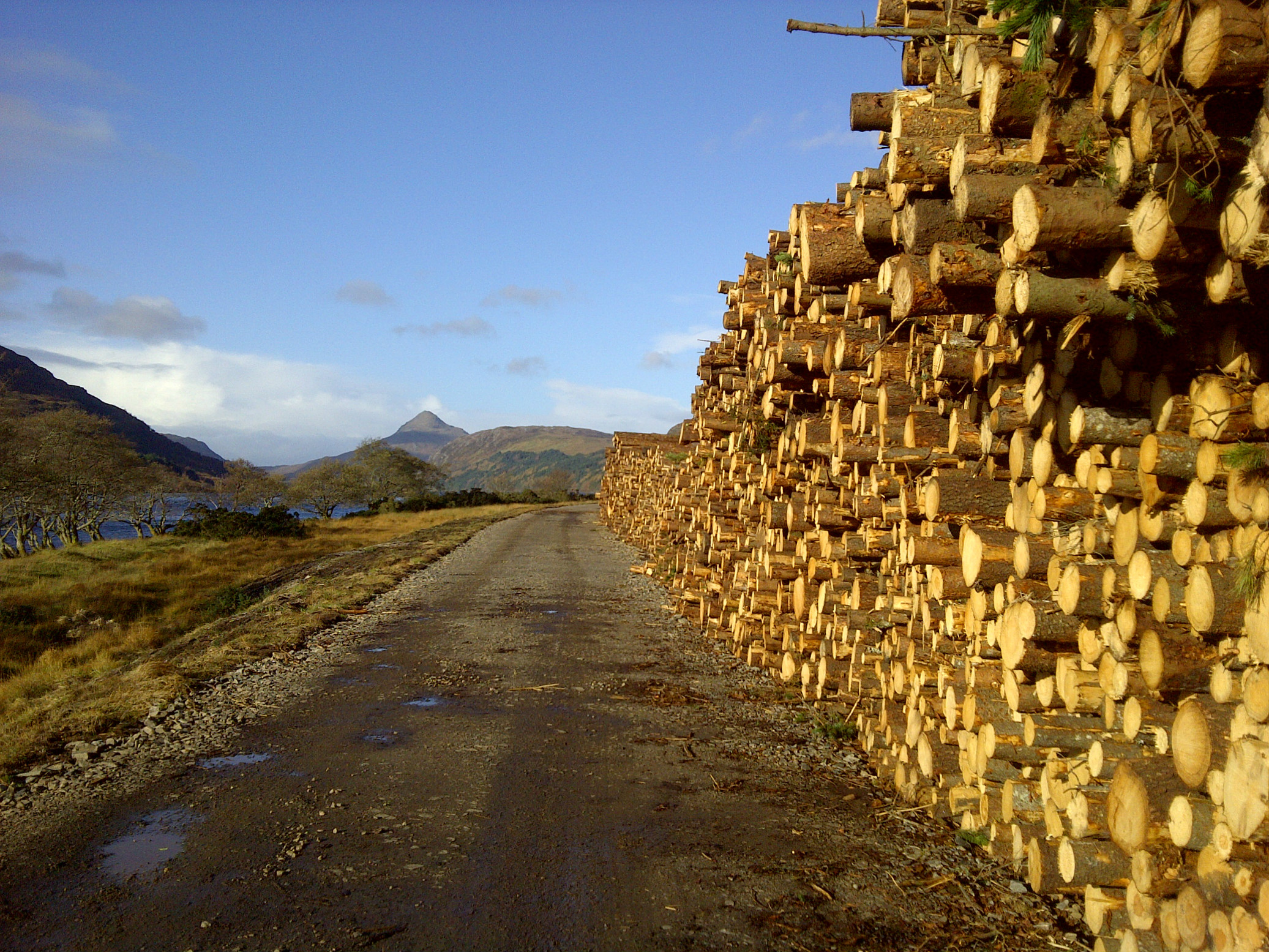
Timber at roadside
A large stack of timber sitting at the roadside looks impressive, but it is not something to be too proud about. Timber is sold by weight in the UK and it will be drying out and becoming lighter while it is stacked here. The sooner it is removed from the site and delivered to the sawmill (or other end user) the less weight it loses and the more money the client earns. Furthermore, rapid despatch helps the client's cash flow as it could be several weeks before the income is received.
In this particular case, the site was close to the road, so the timber stacks were being assembled at a faster pace than usual. The route to the market involved weak roads and there was a restriction in place on the amount of daily visits by timber wagons. This compounded the problem by slowing-down the road extraction aspect of the job. Just one of the many challenges when harvesting timber!

Get off my land!
I was fortunate enough to be managing a forest that contained a nesting pair of white-tailed sea eagles. These fantastic birds are slowly spreading around the Scottish coastline. Being a protected species, I had to be careful that they suffered no ill-effect from some future timber harvesting works that were being planned. At the time, I did not know whether the adult birds had successfully produced offspring so, in cooperation with RSPB Scotland and Scottish Natural Heritage, I arranged for Justin Grant and Abigail Rhodes to climb the tree containing the nest and check the health of any chicks that were inside. They were met with this young fellow!
Cute feet....

Stac Pollaidh one late winter morning
One of the great aspects of the job is being out and about in the Highlands at times of the year. I took this picture of Stac Pollaidh as I drove through the Assynt hills one late winter morning.
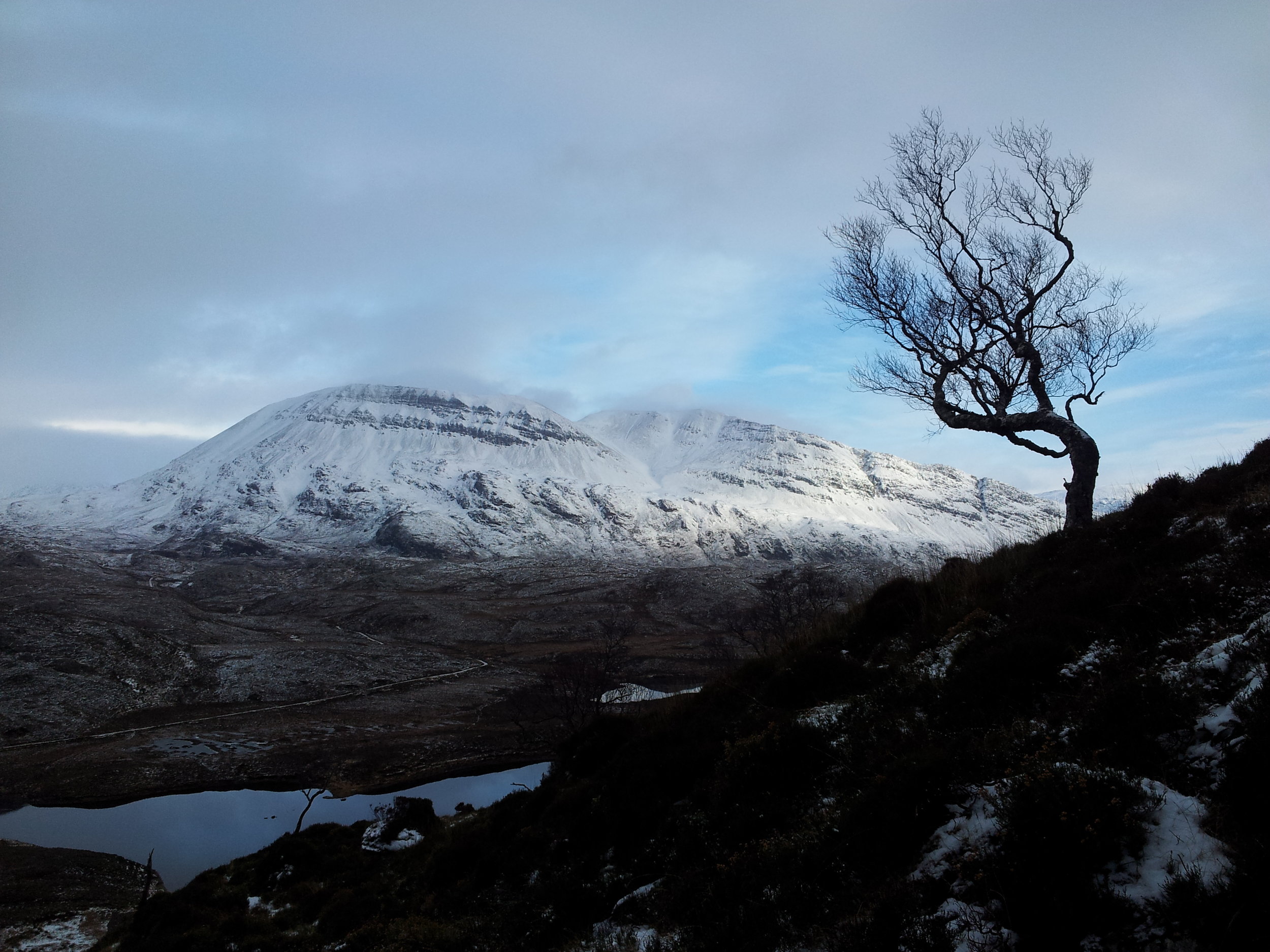
A lone birch on the lower slopes (Ben Arkle in the background)
I was planning a new deer fence to protect some woodland that had been classed as a Site of Special Scientific Interest (SSSI). This meant a long walk on a wintry day to find the best route. I took this photo during a break in the weather. I was standing on the lower slopes of Ben Stack and looking across to Ben Arkle on the fabulous Reay Forest Estate.
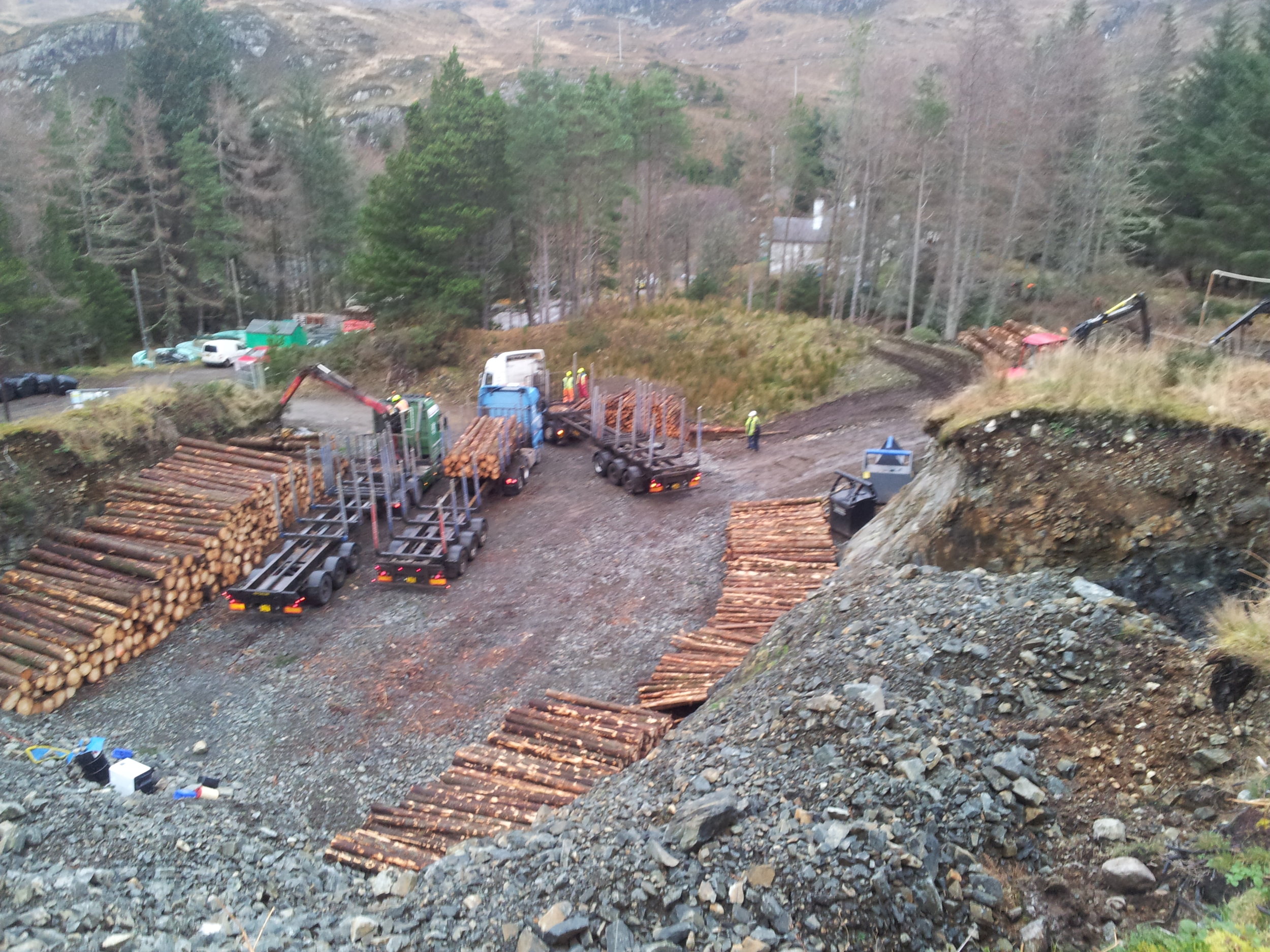
Making the most of a tight space
My client's woodland was not very accessible, but they did have an informal quarry area that, with some lateral thinking and the construction of a short extraction route for the site forwarder, provided just enough space to store and load the timber before it went off to the market. Here, three wagons try to make the most of the available space.
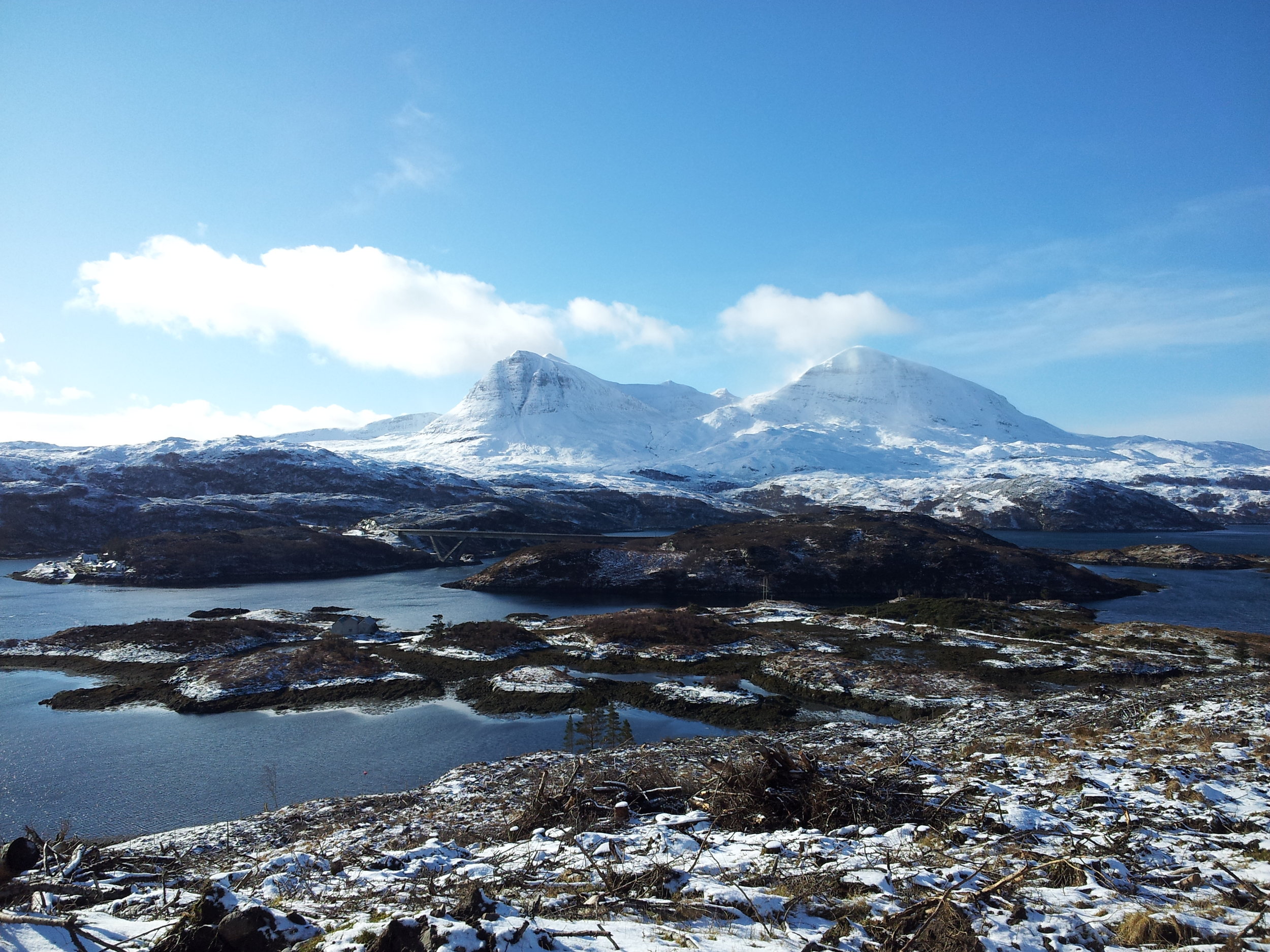
Quinag and Kylesku
This is a picture of Quinag that I took when working on a restocking plan on the other side of the water to the small settlement of Kylesku, North West Sutherland.
It was a cold day but, as can be seen, the air was clear and the views superb.
The restocking was taking place after recent timber harvesting works and the plan was to plant native broadleaf trees to replace the previous cover of mature non-native conifers that had been felled and the timber removed.
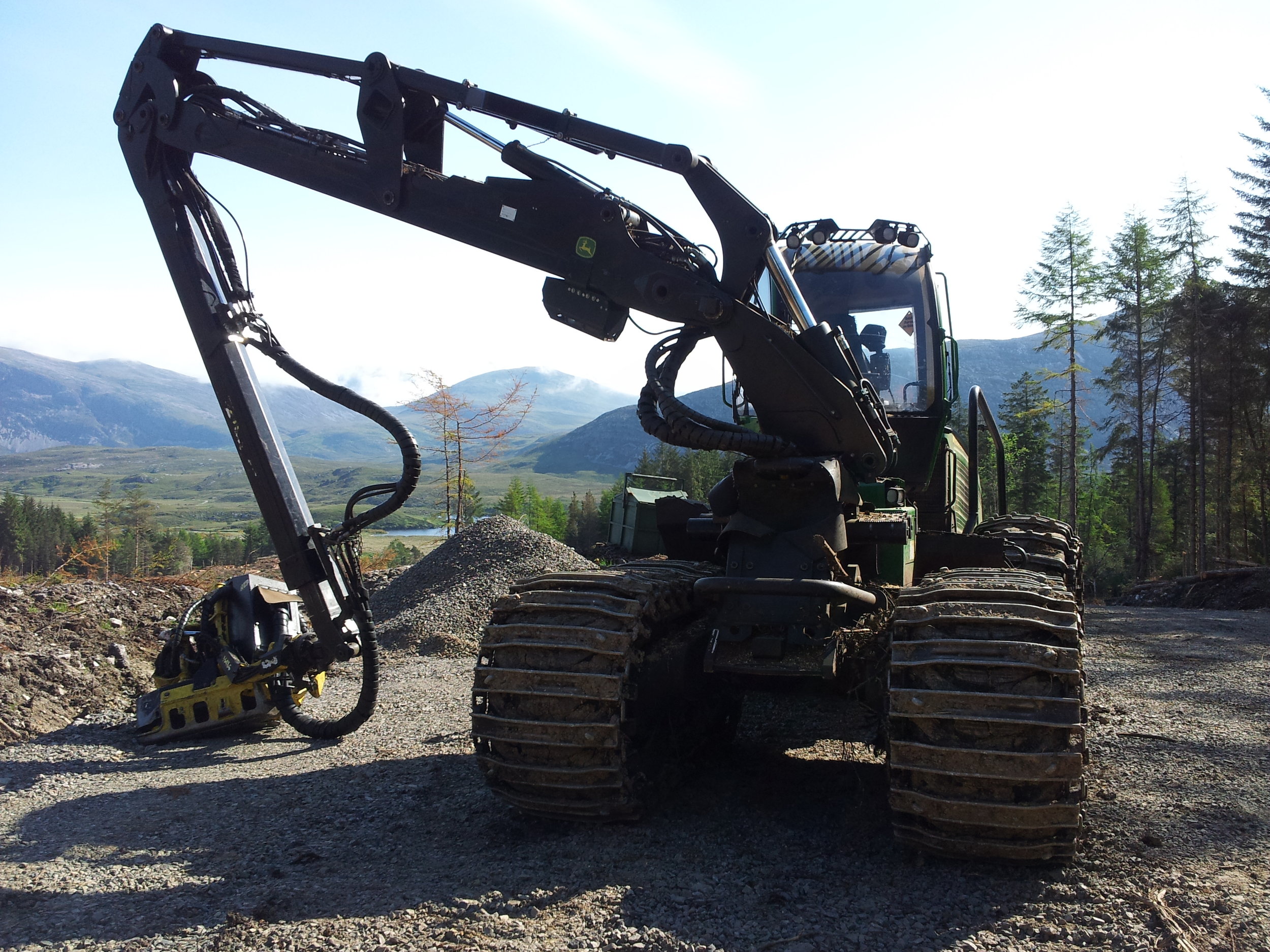
Mechanised timber harvesting
Some people still think that timber is felled with chainsaws. While this is partly true, most of the work on all but the smallest sites is undertaken by purpose-built harvesters. Originally just an excavator with a harvesting head instead of a bucket, today's machines are built for the job and are very impressive to see in action. They make light work of the tree felling process and have many safety features to protect the operator.

Ground preparation
Here, an excavator prepares new ground for the planting of trees for a new native woodland.
The peaty soil is being turned over to create a weed-free planting position and to bring sub-surface minerals to within reach of the young plants. This process also creates a drier planting position for the young trees which will help them to establish in areas of high rainfall or where soils can be waterlogged according to the season.
It takes a skilled operator to create the mounds at the correct spacing and to drive a heavy excavator through these remote and often boggy locations.
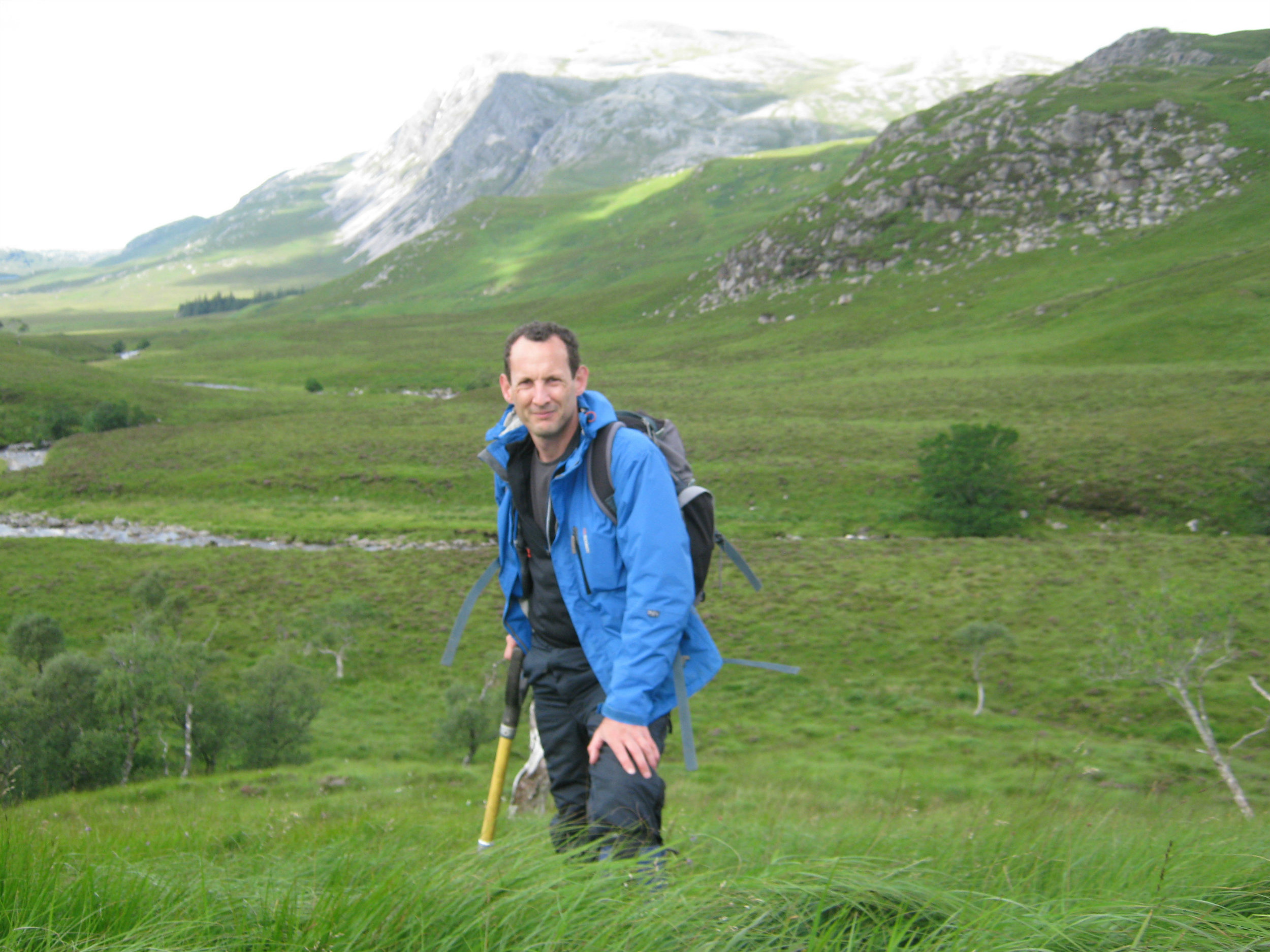
Tim Lucas
This is me circa 2014, taking a break from surveying ground in Sutherland for a new native woodland. With a few simple tools (a spade, a peat probe, an aerial photo or map, and a GPS) it is possible to quickly identify the tree planting potential of any given area of land.

A sturdy new bridge
Occasionally, simple timber harvesting projects can be complicated by off-site factors.
Here, a new permanent bridge was required along an old estate road that was being upgraded so that the 44-ton timber wagons could reach the harvesting site.
A specification for the bridge was included in the tender for resurfacing the road and competent contractors were invited to submit a price for the work.
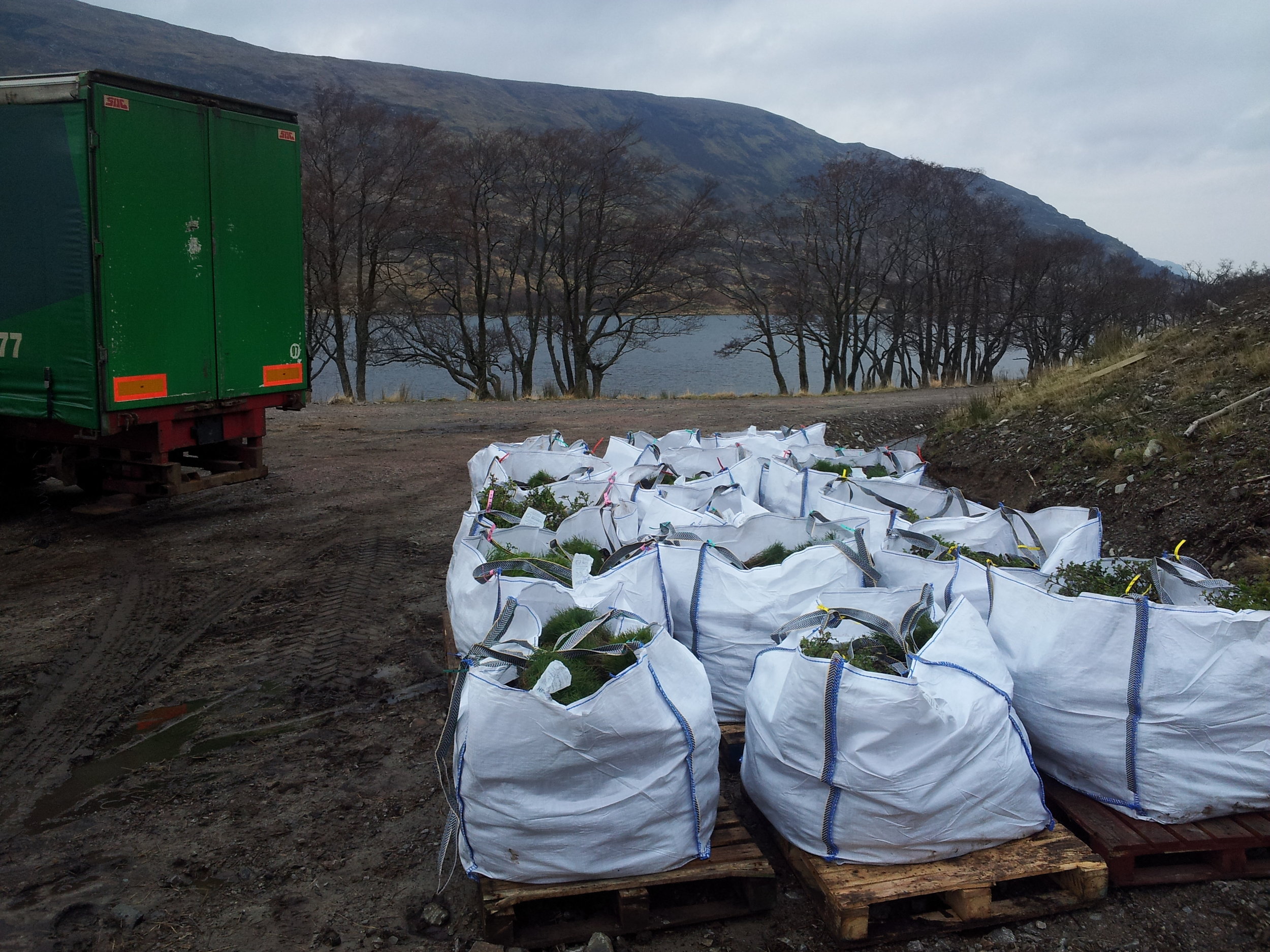
Delivery of young trees
Young pine and native broadleaved trees (birch, rowan, willow, alder, holly and aspen) are delivered to a restock site.
These are cell-grown trees and they would remain in the bags for a few days before being distributed across the steep and remote site by helicopter.
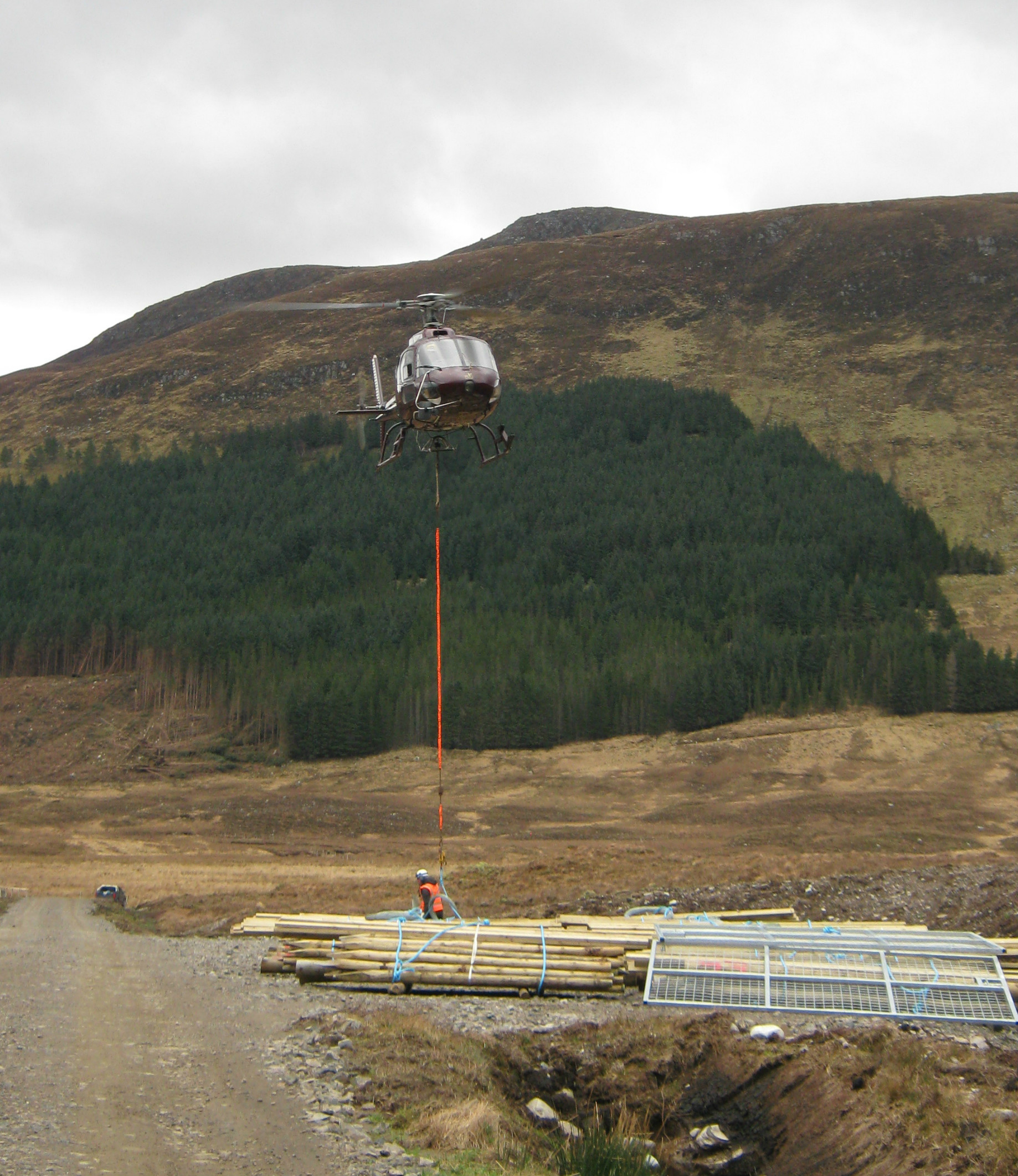
Laying-out fence materials
A helicopter taking bundles of fence materials to a woodland creation project in a hard-to-reach area.
Enough materials for a one hundred metre length of new deer fence are gathered into each individual bundle and taken out to be distributed around the new fence line in a process called 'laying-out'.
The forest manager works with the fencing contractor to ensure that everything goes smoothly and that the right materials arrive in the right location. For example, some bundles may have an added field gate or may contain extra timber if the ground is particularly rough.
Moving materials around by hand is a slow and expensive business and it can be hazardous if the ground is soft, steeply sloping, or just plain remote. Despite appearing to be an expensive luxury, helicopter layout can often be cheaper and is always safer.

Bundles of deer fence materials waiting for helicopter uplift
This is a picture of deer fence materials waiting to be distributed ('laid-out') around the perimeter of a new native woodland. Each contractor has a slightly different approach. Here, the bundles are separated by deer stobs.
It is not unusual for fence materials to be laid-out by helicopter when the site is not very accessible. It is not cheap, but it compares favourably to other methods and is always quicker and often safer.
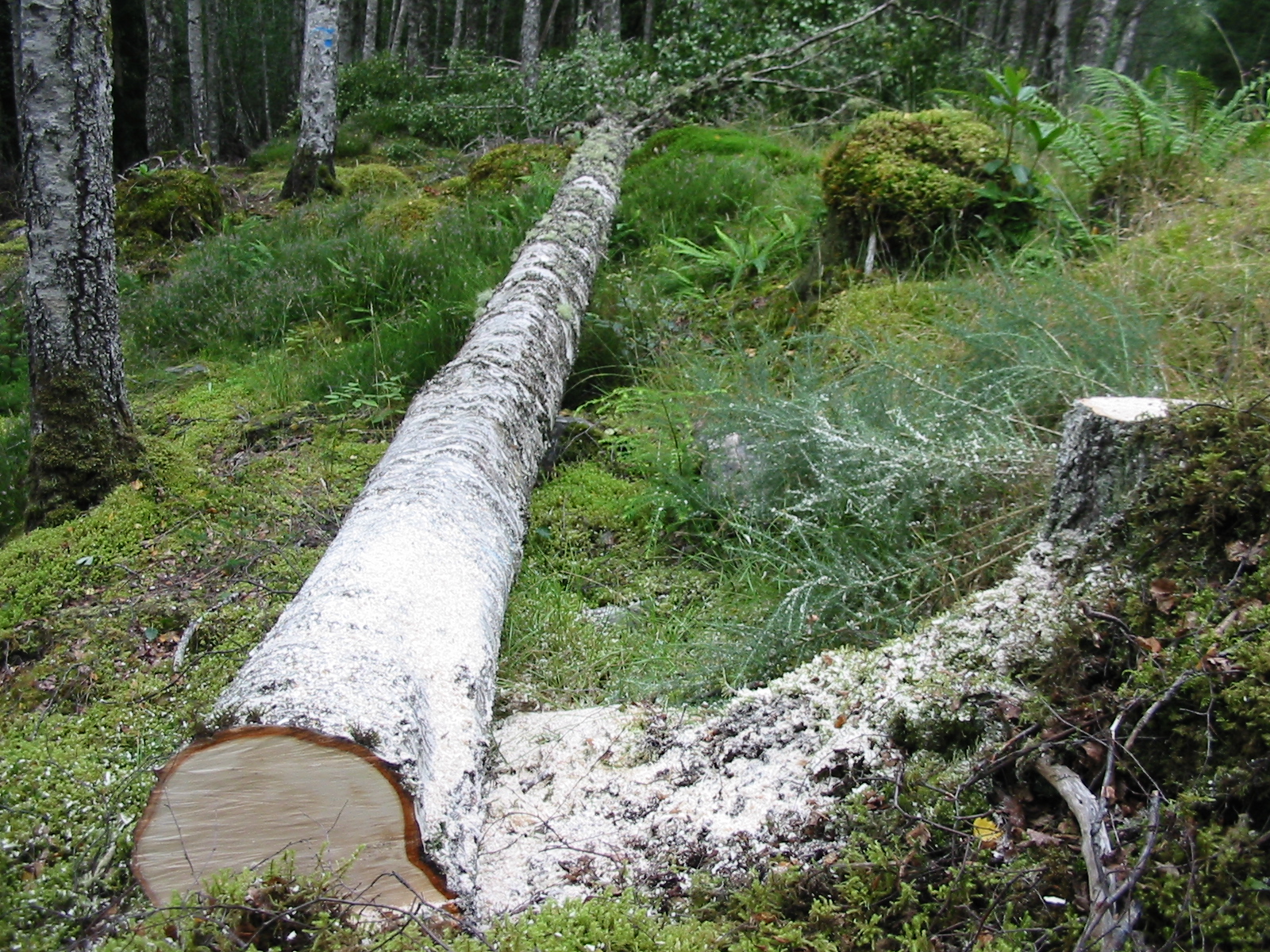
Birch sawlogs
The picture shows an unusually-good Silver birch (B. pendula) sawlog.
A client wished to restock his woodland with a pine and birch mix and had very specific requirements for the work. I could not obtain the correct specification birch planting stock from the usual suppliers, so I suggested that we could gather seed locally and have it contract grown in a tree nursery.
Because timber production was a primary objective, a straight and lightly-branched phenotype was preferable. To this effect, I located and visited a stand of birch near Inverness that exhibited the desired characteristics. The owner of the stand was very kind and allowed me to fell a few trees to gather viable seed from the catkins hanging in the crowns.
With some trepidation that there would be no viable seed to gather if my timing was incorrect, the trees were felled and the seed sent off to be cleaned and subsequently planted.
Germination was excellent and I was rewarded with some fine planting stock in subsequent years.
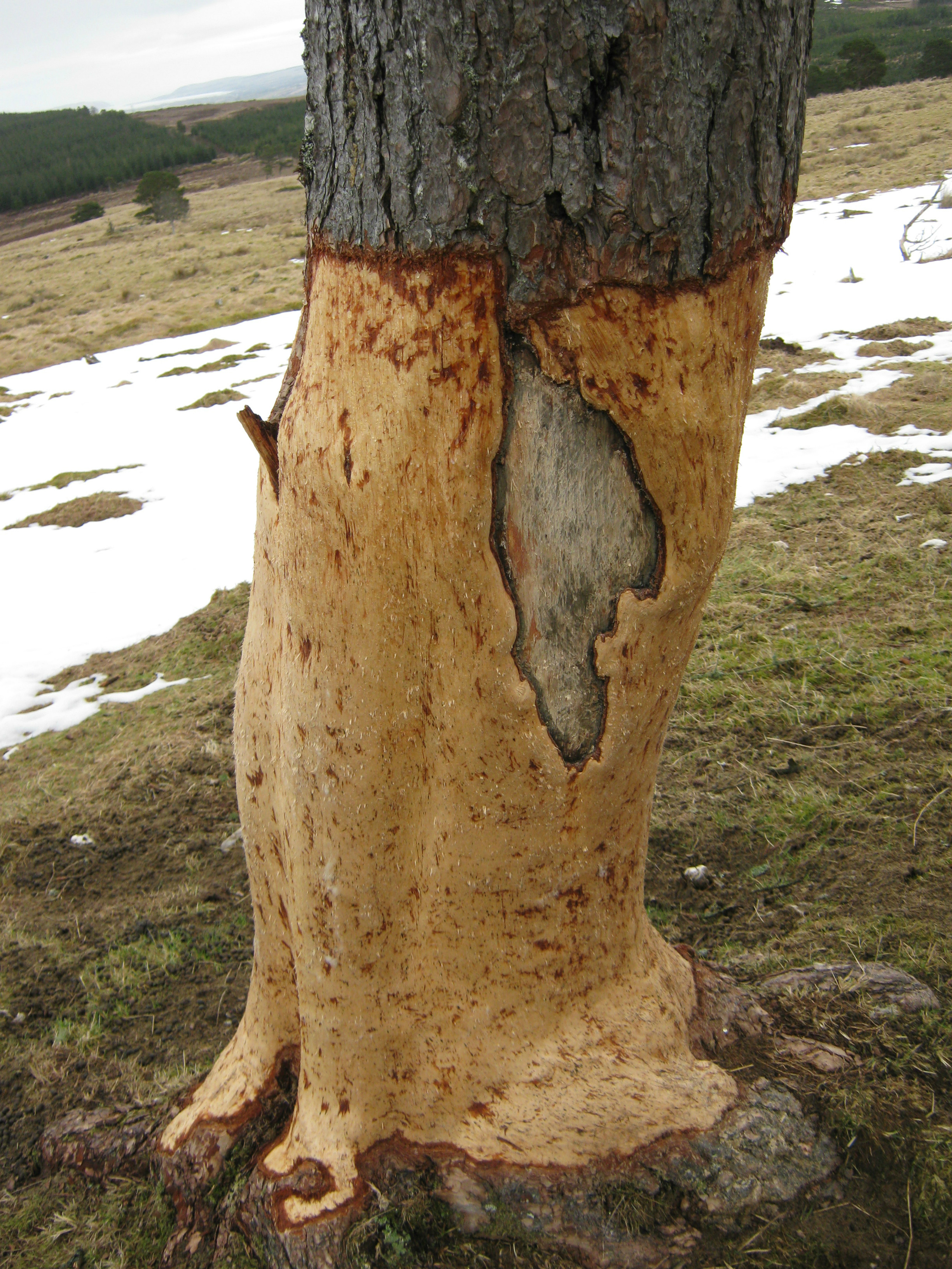
Extreme sheep damage
Several years ago, during an unusually cold and prolonged winter, I was working on a woodland establishment project on a farm.
Late one day, a sudden snowstorm prevented the farmer from putting extra food out for his sheep. The weather worsened and he could get access to them for a couple of days. In their hunger, the sheep ate anything they could find, including the bark of this mature Scots pine!
I thought it was interesting that there was such a well-defined line where the bark was suddenly beyond the reach of even the most stretchy sheep....
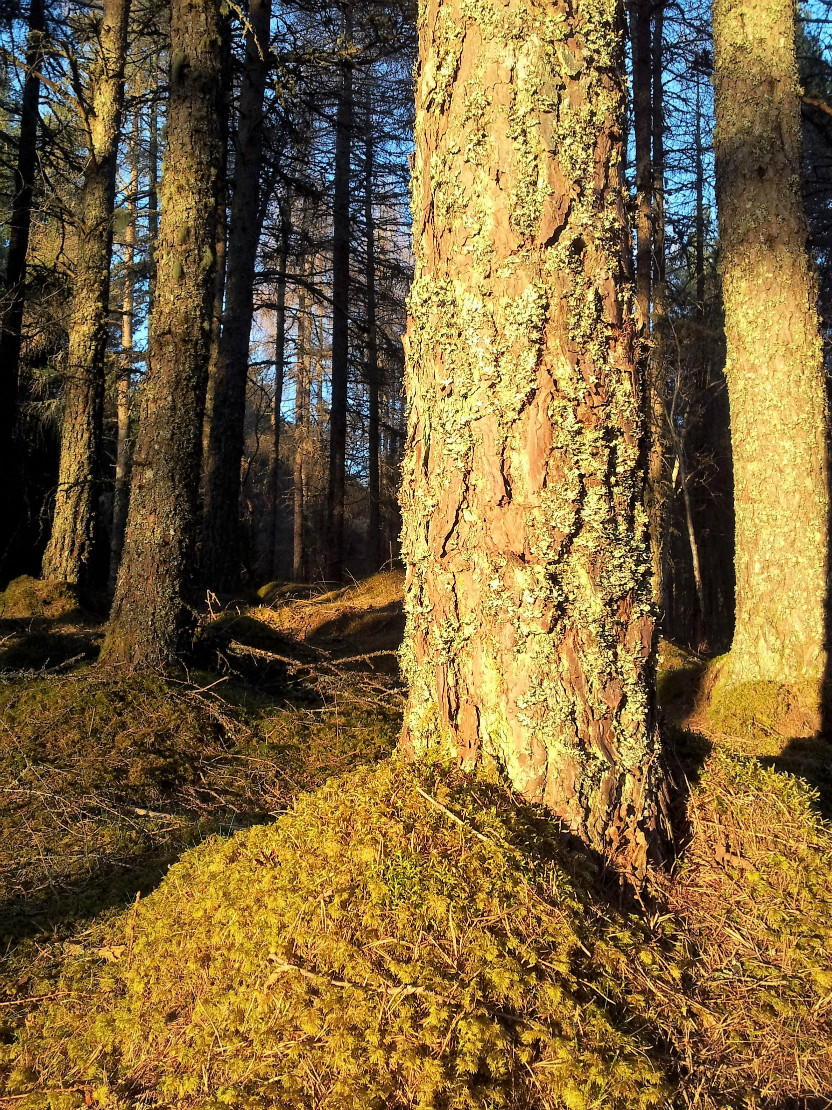
Plantations can be attractive too!
The colours in a stand of pine and larch are picked-out by the late evening sun.
It was great to walk among these trees and proof, to me, that owning and managing woodland isn't just about the timber, or even the wildlife and the environment. Trees and woodlands provide amenity benefits and aesthetic values too.
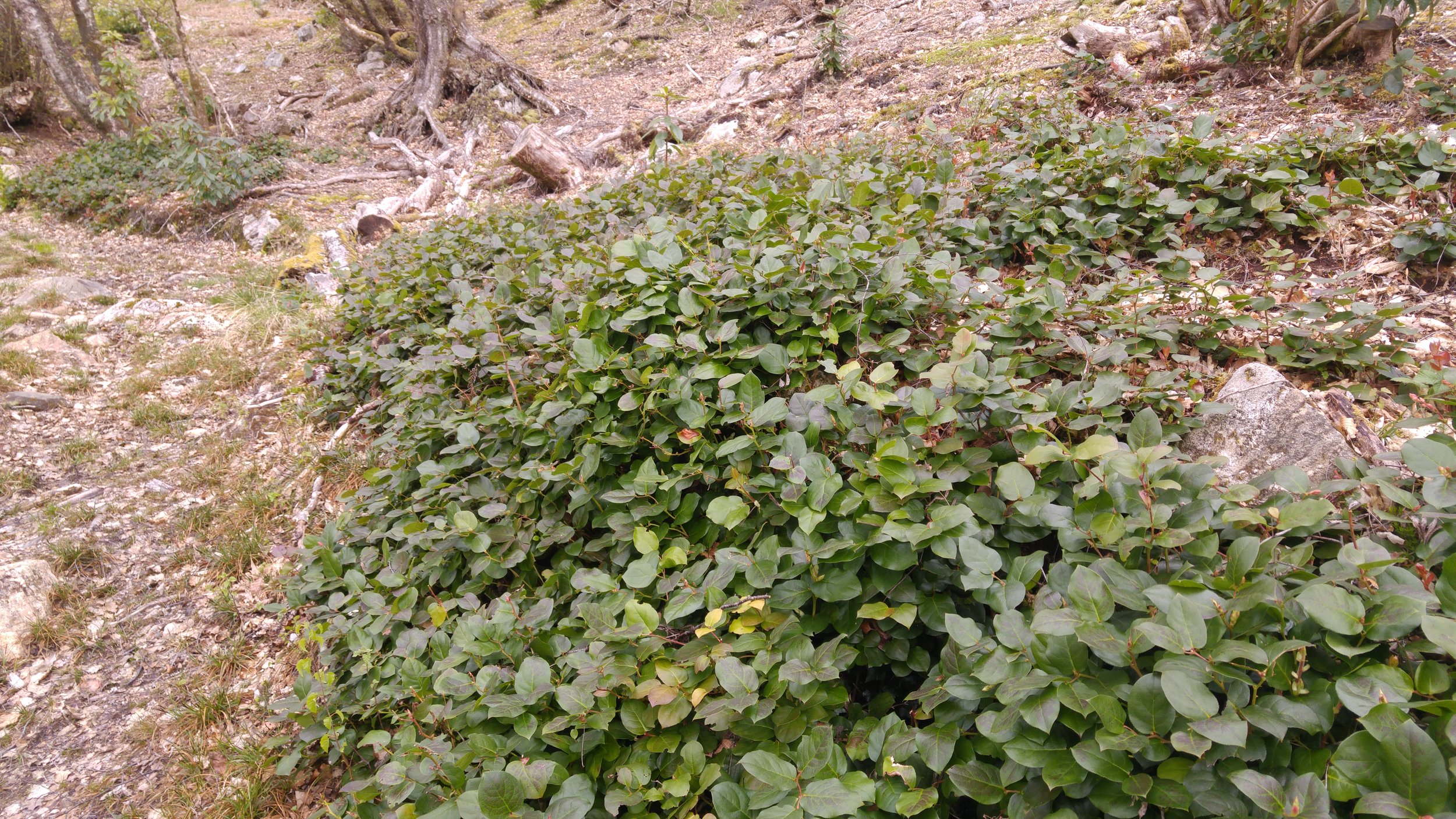
Gaultheria shallon
Gaultheria shallon ('Shallon') provides great for ground cover for game birds and can be very useful in a garden situation. Unfortunately, the very characteristics that make it so suited for these jobs (spreads rapidly; thicket forming; shade tolerant) can make it a nasty invasive species in the wrong circumstances. It likes the Highland climate and I have seen it spreading through native woodland and along the edges of watercourses.

Small grave, Ardtoe
I saw this small grave on private land in Ardtoe while I was undertaking a tree survey. I guess a dog is buried here. What a fitting resting place!

Rhododendron cut and burn
There are plenty of good reasons for clearing land of Rhododendron ponticum. In this case, it was infected with the plant pathogen Phytopthora ramorum so it had to go.
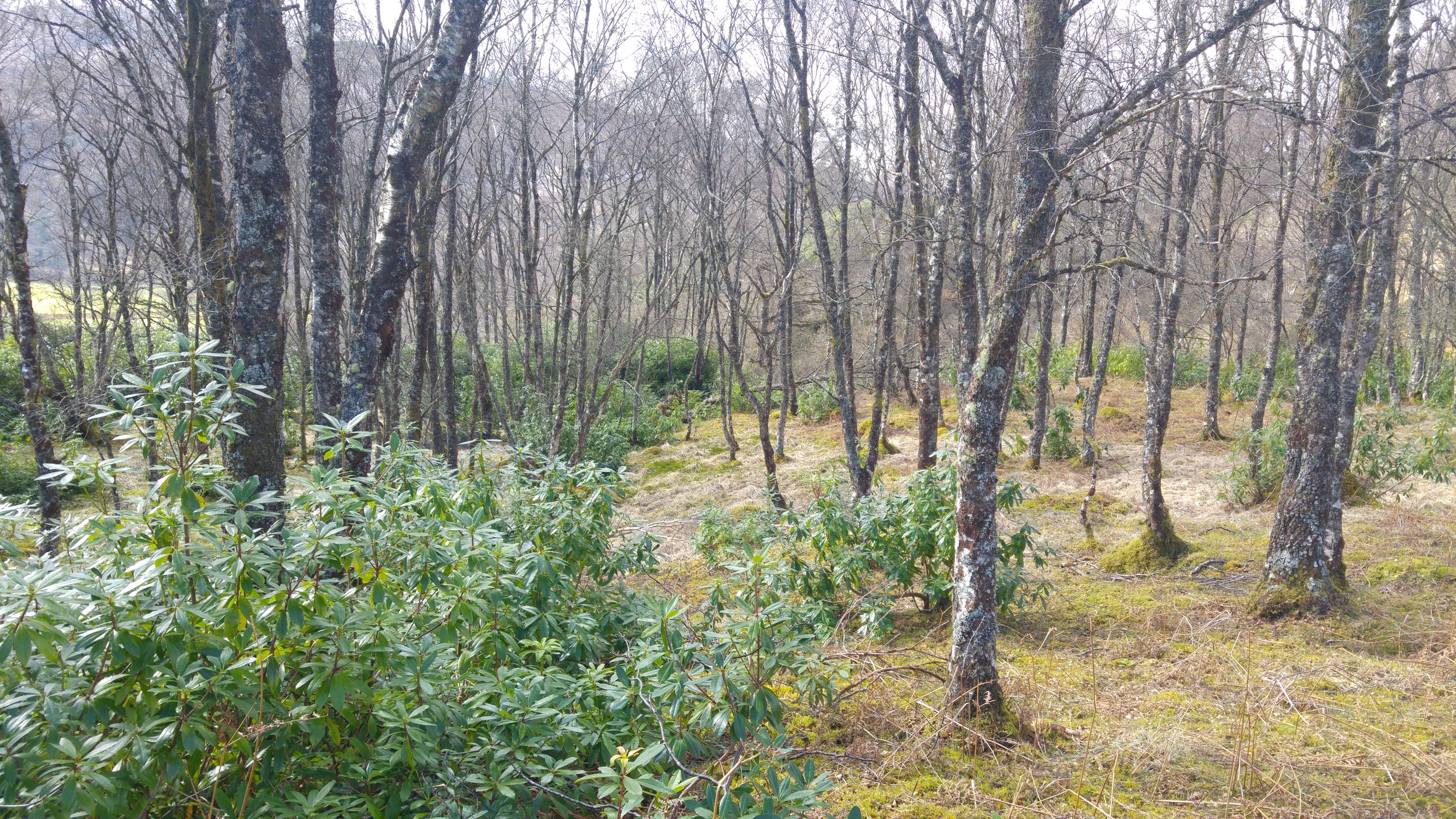
Rhodendron ponticum - the green menace!
I was asked to survey the spread of Rhododendron ponticum across a private estate. It was everywhere: private gardens, timber stands and, as this picture shows, native woodland.

Feral pigs 1
I found these signs of feral pigs throughout an area where I was undertaking a survey. I did not realise that they had spread so far along the Great Glen and was initially puzzled as to what could be disturbing the ground in this manner. It obviously was not deer and seemed rather extensive for badgers (my first thoughts). Then the penny dropped: I had seen something similar before in the Forest of Dean, where feral pigs had become a local cause celebre for the ground disturbance they were causing.
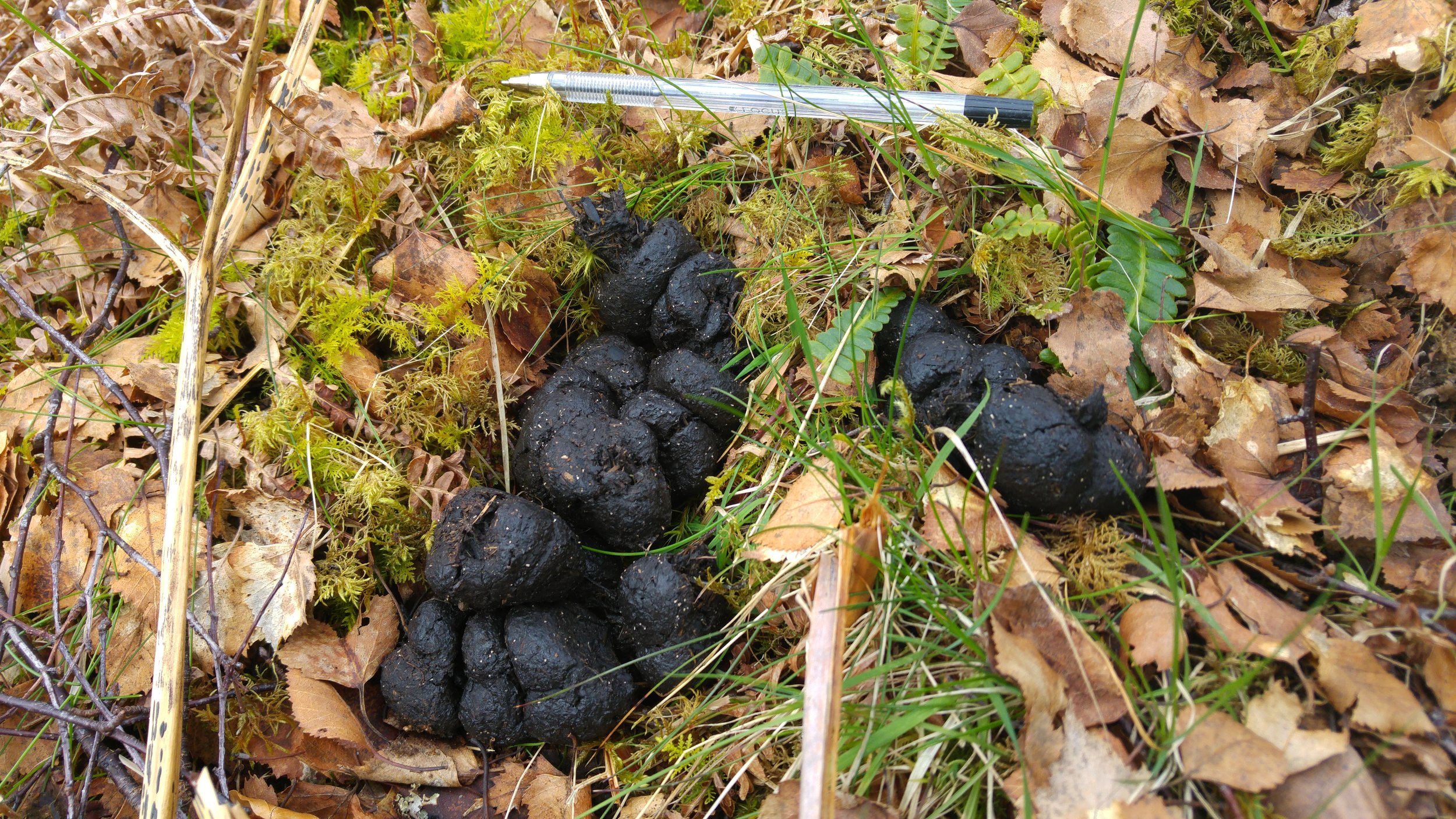
Feral pigs 2
I was seeing these puzzling scat throughout an area in which I was working. It was only when I saw the ground disturbance that feral pigs had caused in other nearby areas that the penny dropped: I was seeing pig faeces.
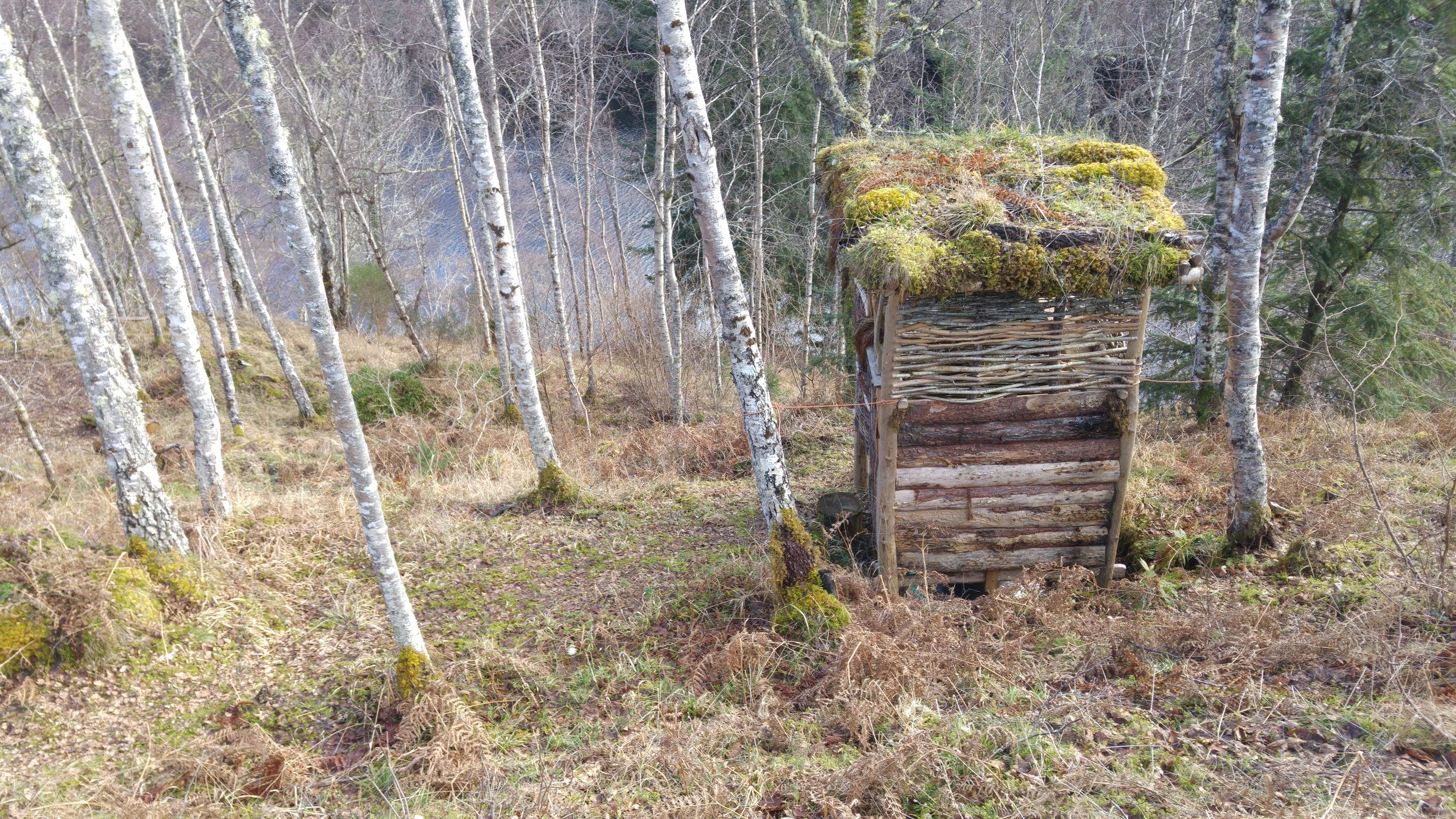
Composting toilet
I was asked to produce a management plan for a small woodland along the Moray Firth. The owner required one to support a planning application and also wanted advice on how to best manage his birch and other broadleaves for timber production.
The owner would spend long hours working in his wood and cleverly addressed one of the common problems associated with a lack of welfare facilities by building this self composting toilet.
The view was great but I bet the midges meant that you wouldn't want sit around for too long to enjoy it...

Regenerating rhododendron from a previously cut stump
In an ideal world, it would not be necessary to return to a site once the work had been done.
However, things are rarely 'ideal'.
In this case, a rhododendron bush has been cut down and glyphosate applied to the stump (the horizontal chainsaw cuts where the chemical would have been applied are clearly visible).
Rhododendron can be a pernicious weed and, as in this case, the chemical treatment was not quite enough and new shoots have appeared. In two to three years this will be a substantial bush once more so a further timely treatment now will save both time and money.

Planning new woodland
It is a good idea to dig a few soil pits when planning new woodlands.
This area of pasture on a farm was clearly much better than many places where new woodlands are usually planted in the uplands.
However, surface water was collecting (visible in the picture) so I decided to see what was underneath the grassy sward.

The site of a new woodland
Here, an upland sheep farmer wished to increase tree cover on his land. He had previously planted new woodland nearby with support from early incarnations of a forestry grant scheme.
In this case, the Scotland Rural Development Programme (SRDP) was offering sufficient support to make even a relatively modest new woodland financially worthwhile so I was asked to prepare a plan.
The plan was approved and the establishment work should start in the autumn of 2017 when the pre-planting ground preparation begins.

Tigercat harvester on steep ground
A Tigercat harvester working on steep ground in Sutherland, Highland

Forwarder on steep ground
Mechanised extraction of timer on steep ground in Sutherland, Scotland
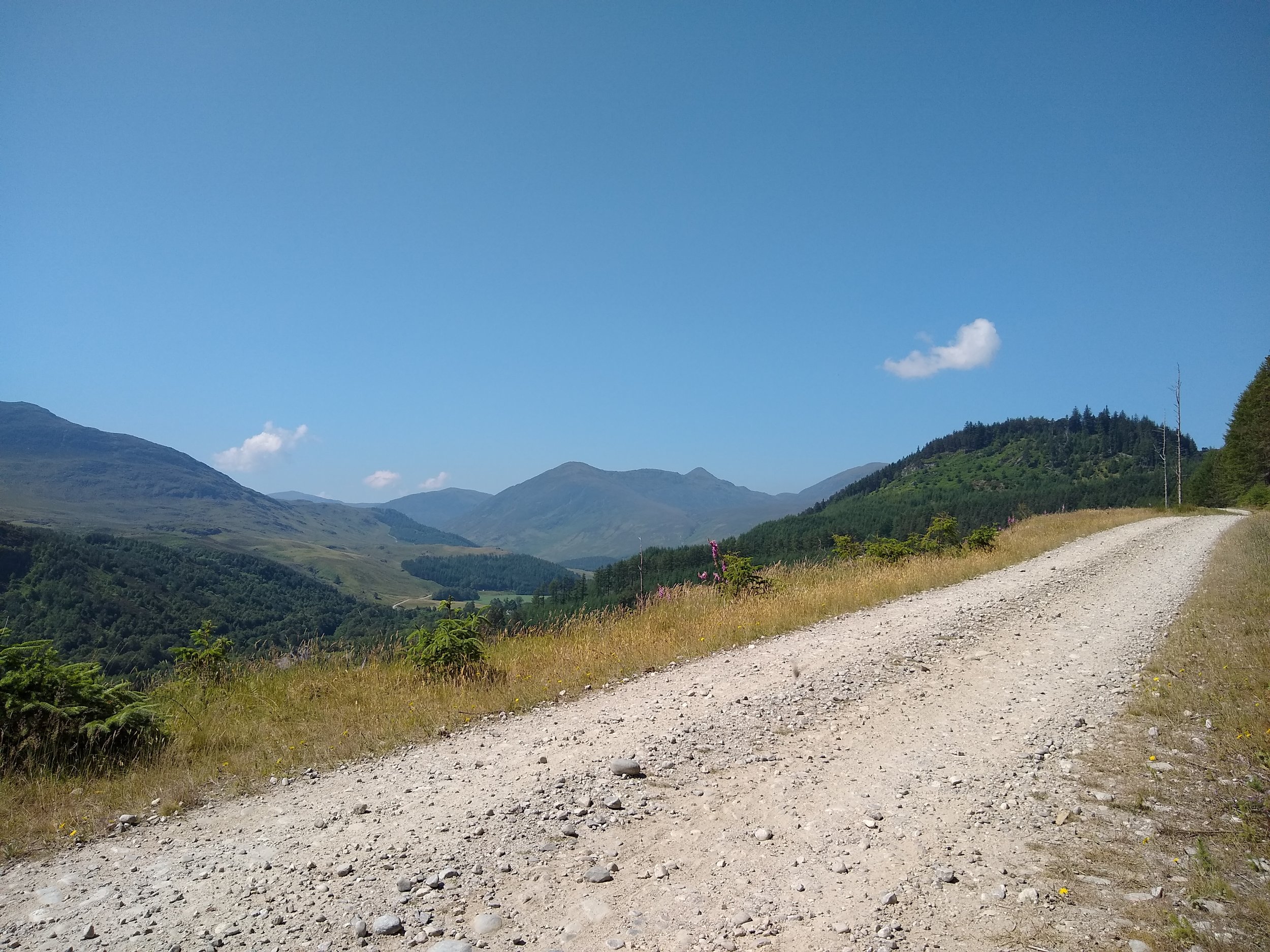
Strathconan, Inverness-shire
Spring and summer 2018 were fantastic. Hardly a drop of rain and some very high temps.
I took this picture when driving along a very hot and dusty forest road in Strathconan.
At the time, I was contracted to Forestry Commission Scotland for about ten weeks, spending one day a week checking pheromone traps in various woodlands around the Beauly Firth.
The traps were intended to attract and catch any Pine tree lappet moths that happened to be present. This was undertaken as part of an annual monitoring programme for this non-native species, which is known to be breeding in woodlands near the small town of Beauly.
Strathconan Forest was an outlying area, well beyond the known breeding grounds of the moth and I found no Pine tree lappet moths here during my checks. Monitoring was undertaken with the kind permission of the landowner, whose assistance was invaluable in monitoring the spread of this species.
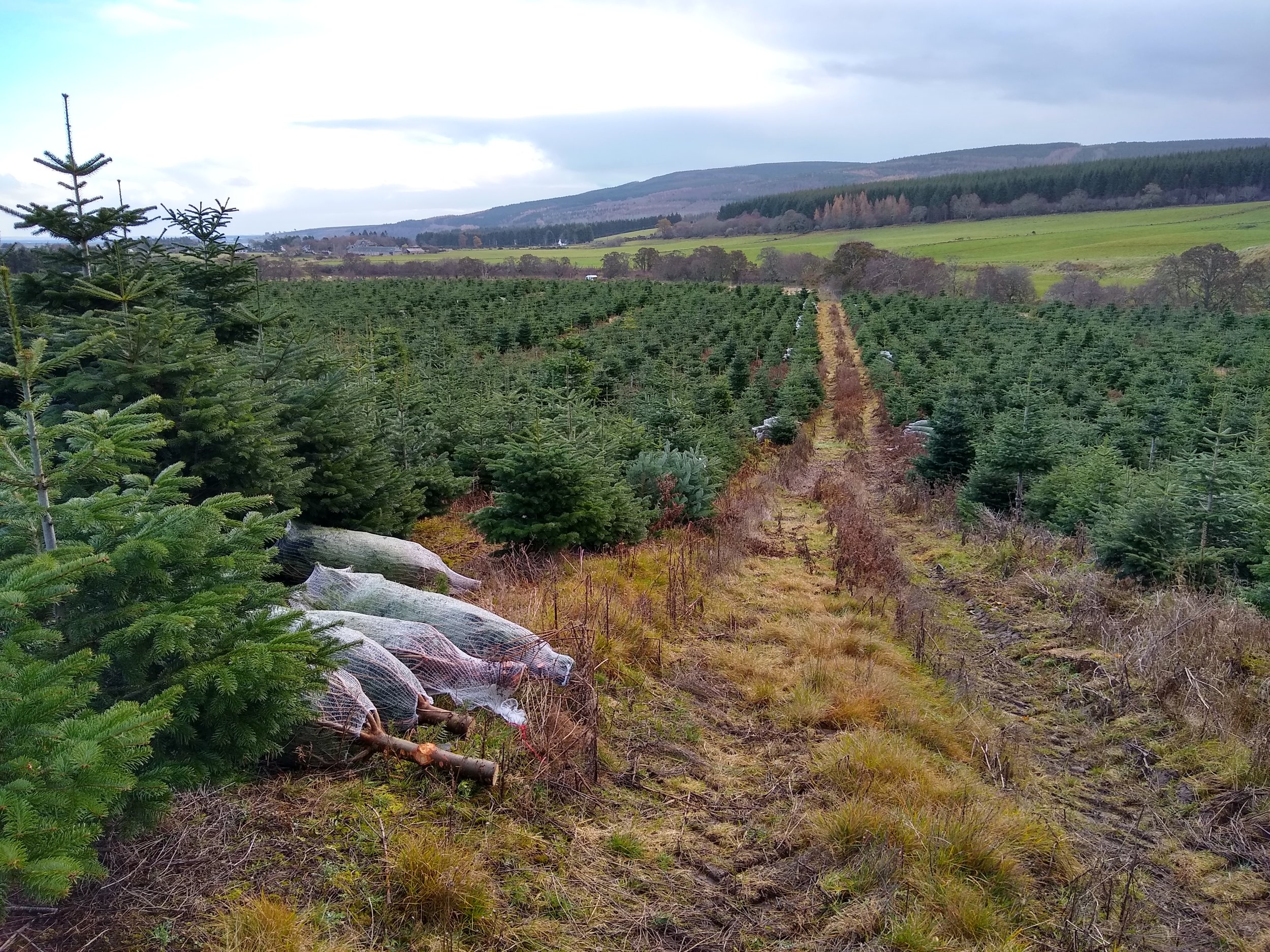
Christmas trees ready to go to market
Nordman fir Christmas trees, bagged-up and ready to go to the market.
This plantation was for sale at the time and a prospective buyer asked for my thoughts on quality of the crop and its potential for generating future income.
In addition to assessing the crop through digital mapping (to establish the productive area) and random plots in the field (to identifying the stocking density and tree sizes) I also investigated access constraints and other site conditions.
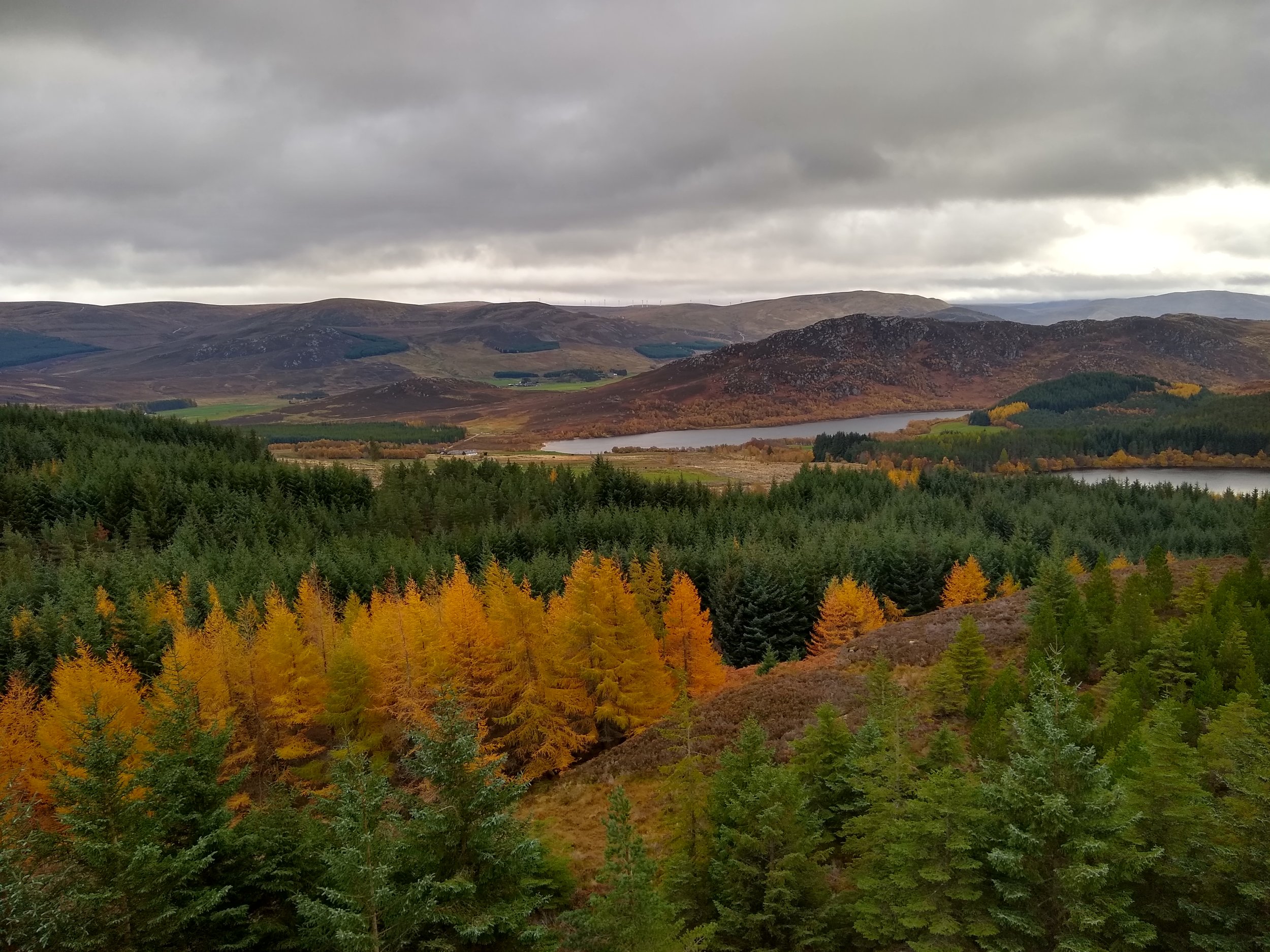
Larch in the autumn landscape
Hybrid larch (Larix x eurolepis) positively glowing in the landscape during the autumn, when its needles change colour before dropping. Unlike many other conifers, it is deciduous.
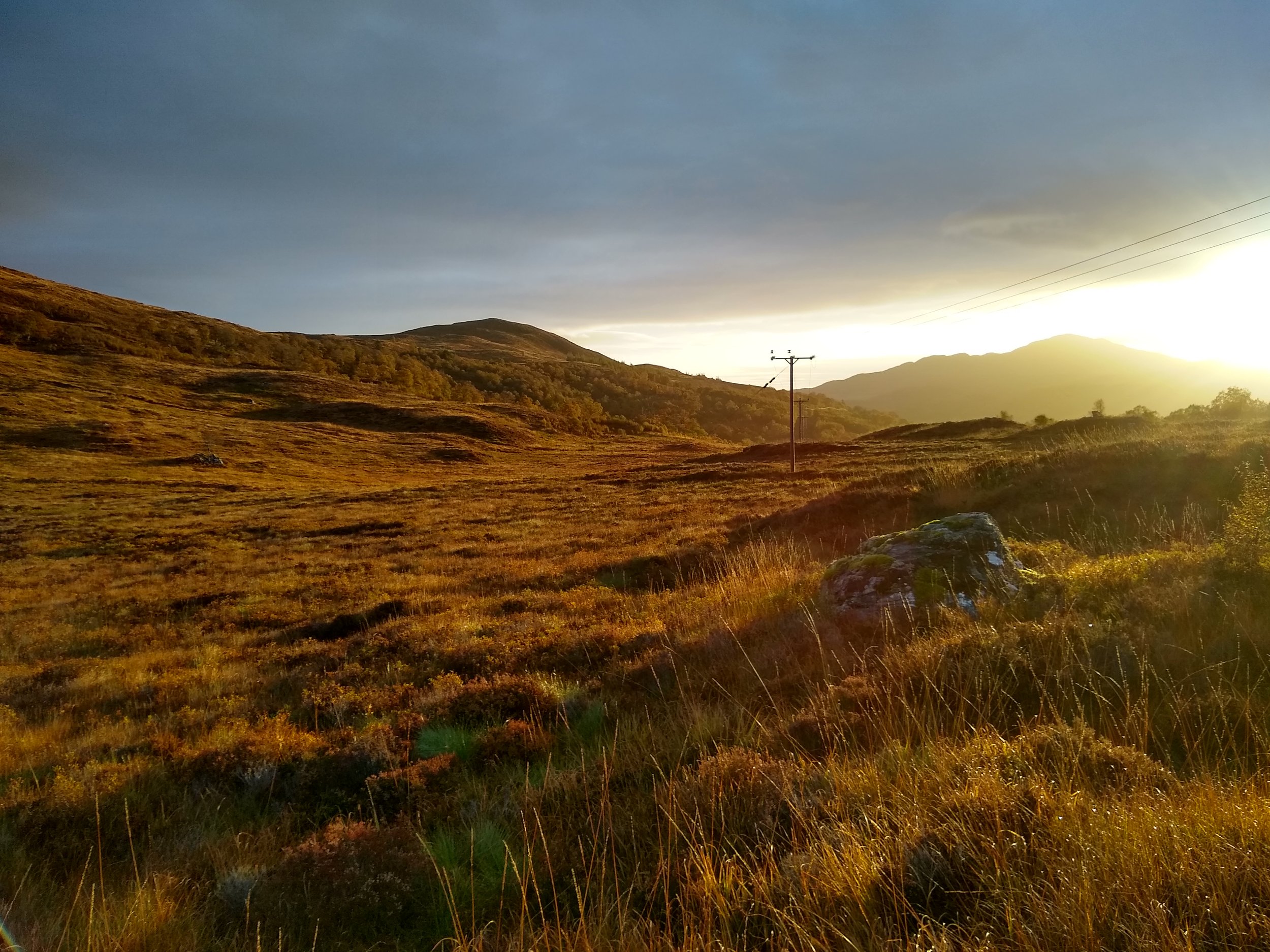
Surveying ground for woodland establishment purposes
Sunrise over an area with potential for planting-up as a new native woodland.
The ground was a little too peaty in this location, but the sun shining on the russet grasses made up for it.
Elsewhere in this parcel of land, my findings were more promising, with shallow peat on top of mineral soil.
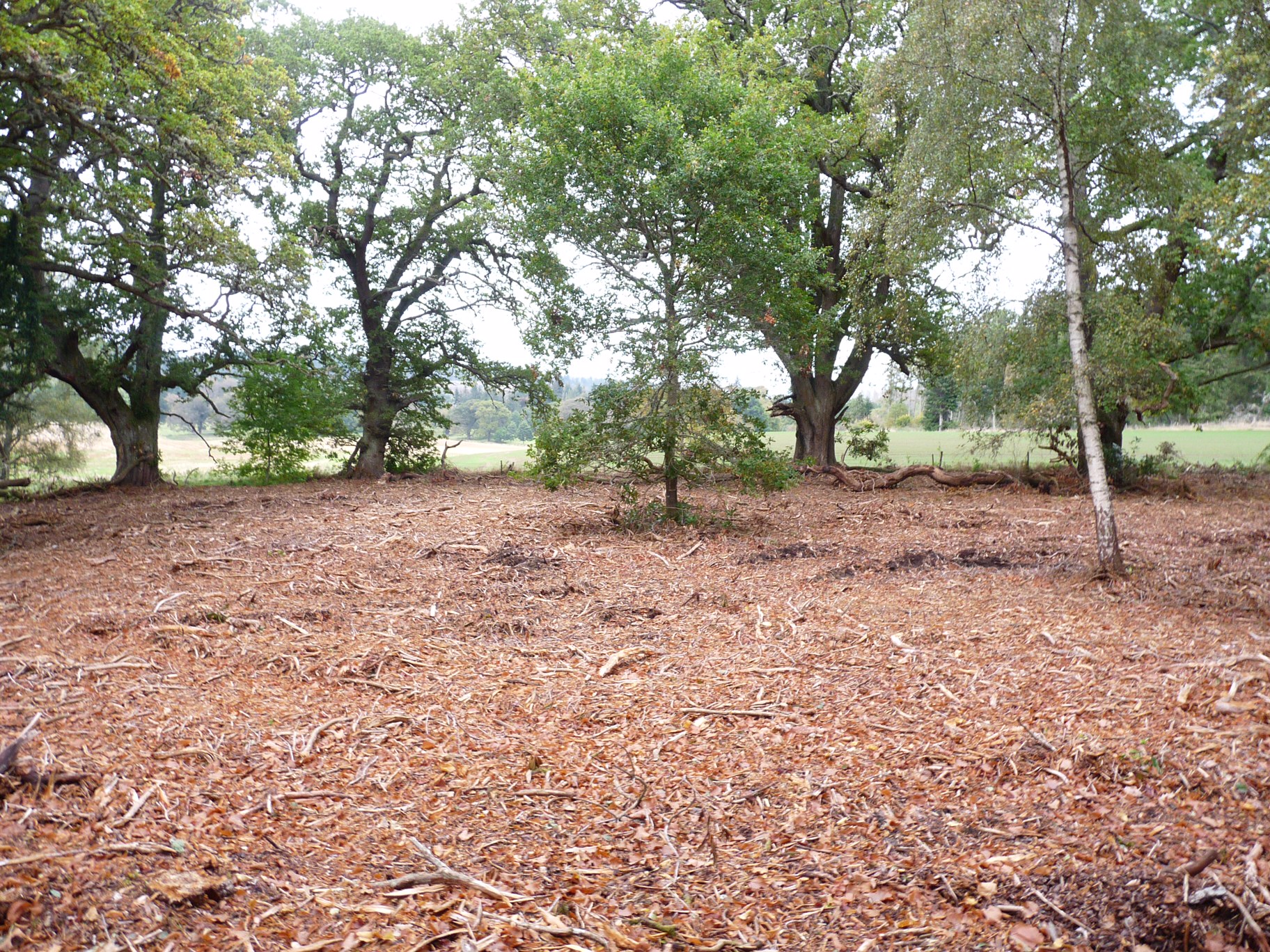
A rhododendron stand after being machine-mulched
If a machine (excavator with flail attachment or similar) can get into a rhododendron stand, it can make light work of the bushes at significantly less cost than motor manual methods.
Both the damage by the flail and the subsequent thick mulch of shredded plant matter helps to suppress new growth from the remains of crowns. Where it does occur, it is usually fairly straightforward to find it and treat it with herbicide.

Birch woodland in Inverness-shire
I took this picture when planning a tree regeneration project in Inverness shire. The autumn picked-out the colours of the existing mature birch woodland beautifully.
With such a substantial seed source nearby, I thought there was an excellent chance that many seedling trees would begin to appear on the adjacent open ground, provided the deer and sheep were removed.

Lochan
I took this picture of a small lochan at around 9 a.m. one late August morning, after walking forty minutes to the open hill land where I was working.
My task that day was to survey some peaty ground to see if it was sufficiently shallow for a new native woodland to be planted. I recall that the summer had been a washout, so it was nice to be working in the sun. Of course, every silver lining has to have a cloud and the flies were particularly bad that day!

Standing stone at Brawlbin Forest
I was measuring standing timber at Brawlbin forest and the process involved identifying and recording where the size of the trees and the stocking density was similar. In this manner the process of establishing the potential timber yield would be made all the more easier, as measurements from one area could be applied to other similar areas.
The method involved a lot of walking and, as the crop was quite young and difficult to move through, I would frequently walk around the edge. It was while doing this that I saw this interesting standing stone on the muir just beyond the forest. Not very tall, but striking because of the surrounding landscape.

Standing stone at Brawbil Forest
I was measuring standing timber at Brawlbin forest and the process involved identifying and recording where the size of the trees and the stocking density was similar. In this manner the process of establishing the potential timber yield would be made all the more easier, as measurements from one area could be applied to other similar areas.

Bright but cool
A view of hill ground near Strathglass, Inverness-shire.
I was working on the design for a small native woodland planting scheme on a cool late winter day. It may appear sunny in the photo, but it did not feel very warm. There was still ice on the small lochan in the middle distance!
This turned-out to be a windy site and snow flurries were still falling in April when the trees were being planted a few years later.
The tall electrical pylons added an additional constraint when planning and undertaking the work. First, the design plan had to ensure that the tree planting was held-back a suitable distance from the live conductors and, second, the operational plan had to consider the risk of machines working near the the hazard.

East coast seascape
I was working on designing a woodland creation project on a farm by the coast at Brora and the water had a lovely turquoise hue in the sun.

Hardy pig
I was checking the condition of a small native woodland on a windy West coast location when this fella (lady?) came over to say ‘hello’.
I thought its ragged fir and grizzled appearance adequately reflected the wild conditions in which it lived!
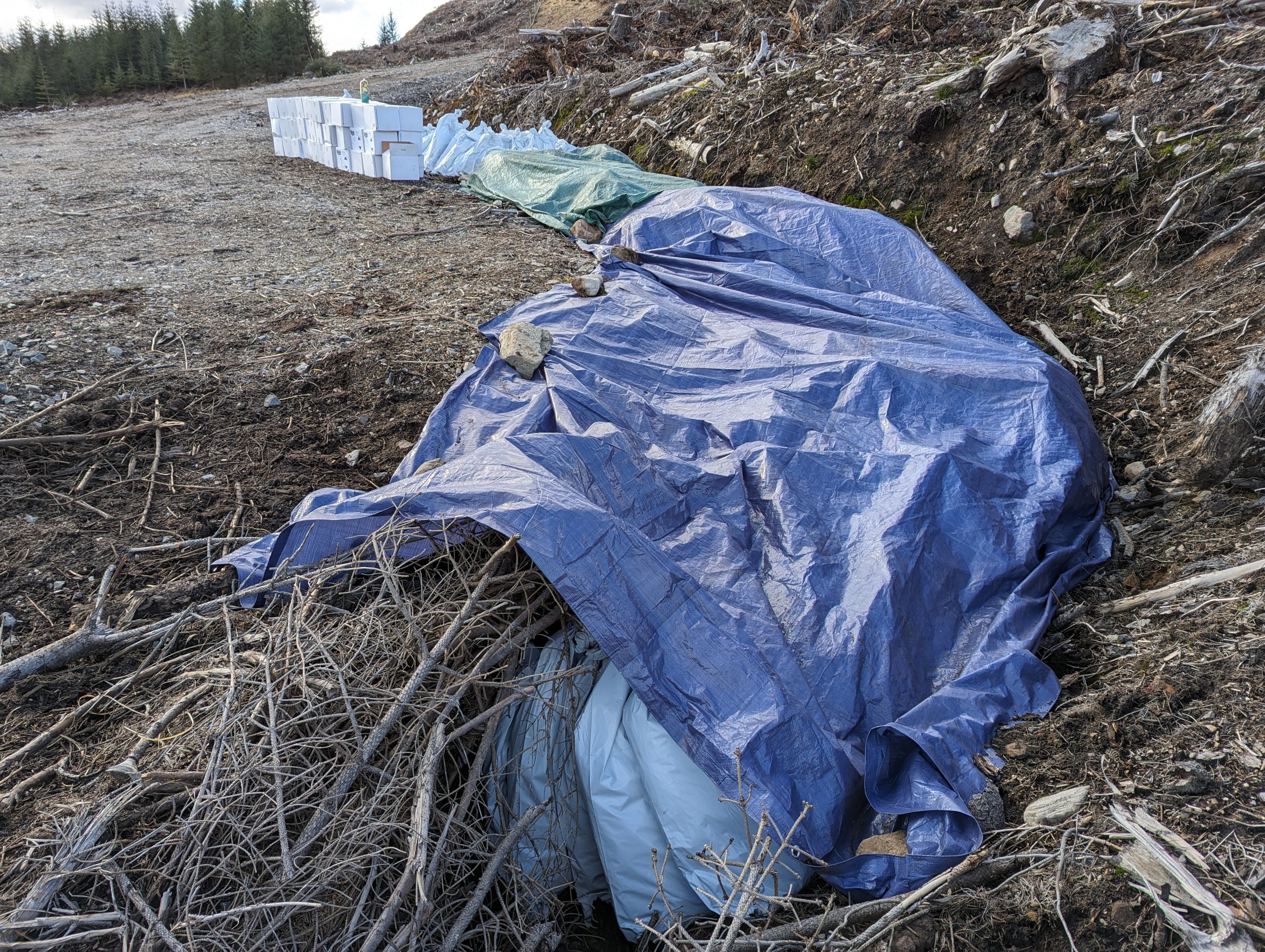
Impromptu tree store
A picture of an impromptu tarpaulin shelter for bare root trees waiting to be planted on a restock site.
It was still March and the weather was cool, but I feared that the trees could get too hot while they wait to be planted, so I decided not to take any chances.
The aim here is to keep the sun off the thick plastic bags containing the trees, while allowing some air movement around them.

Bare root trees waiting to be planted
Bare root trees in the species bags wait to be planted.
The white bags are quite thick and black on the inside, hence their colloquial name, ‘black and white bags’. This design is supposed to keep the trees inside a little cooler than would otherwise be the case.
Some of the trees were in fact destined for a new planting scheme on adjacent ground, hence the boxes of slow release fertiliser on the right.

Lochaber view
I took this picture while looking down the Great Glen towards Fort William and Loch Linnhe - with the Nevis Range on the left - while surveying some hill land woodland creation potential.
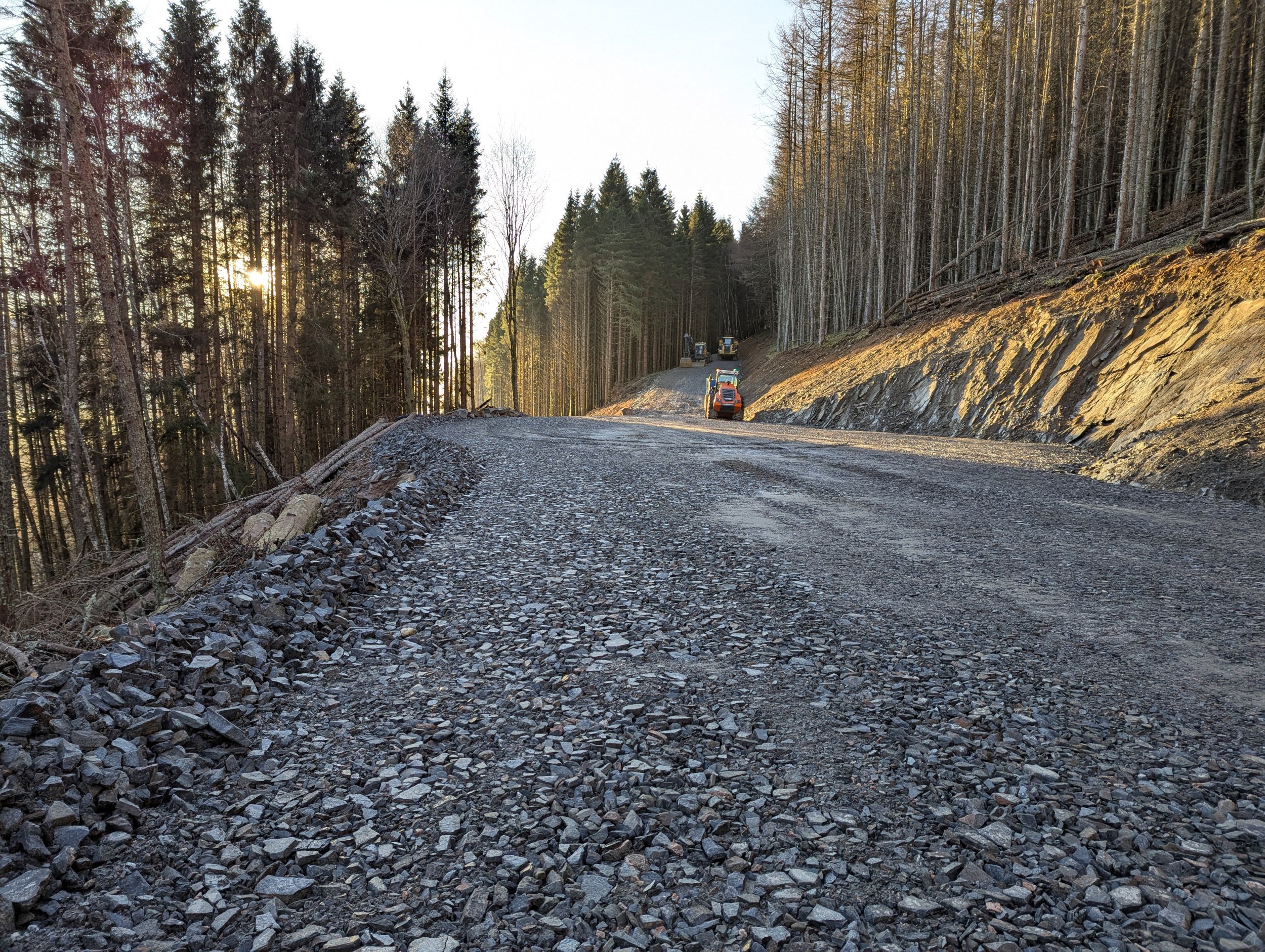
A new timber stacking area
A freshly-built hardstanding for stacking timber, constructed ahead of the start of timber harvesting in this forest near Inverness.
The picture does not do full justice to the difficult landform on which this was built, although the fresh cutting in the solid rock on the right side provides some indication. The civil engineering contractor did a brilliant job.
Some of the forest had to be cleared to make room for this hardstanding and the exposed edges of the remaining stands show the height and quality of the crop.

Oversize trees
These rowan were ordered as 20-40cm bare root transplants and, as the photo shows, the stock the nursery sent was several times larger.
They were far too big for the planting squad to handle. Seeing that it was too late to return them to the nursery and wait for sensible replacements to arrive, I took some secateurs to them and cut them down to the very first bud from the root collar. This left the stems at around 100 mm tall.
Despite the harsh treatment, the trees flourished during the summer after planting, most likely assisted by their enormous oversize rootballs!
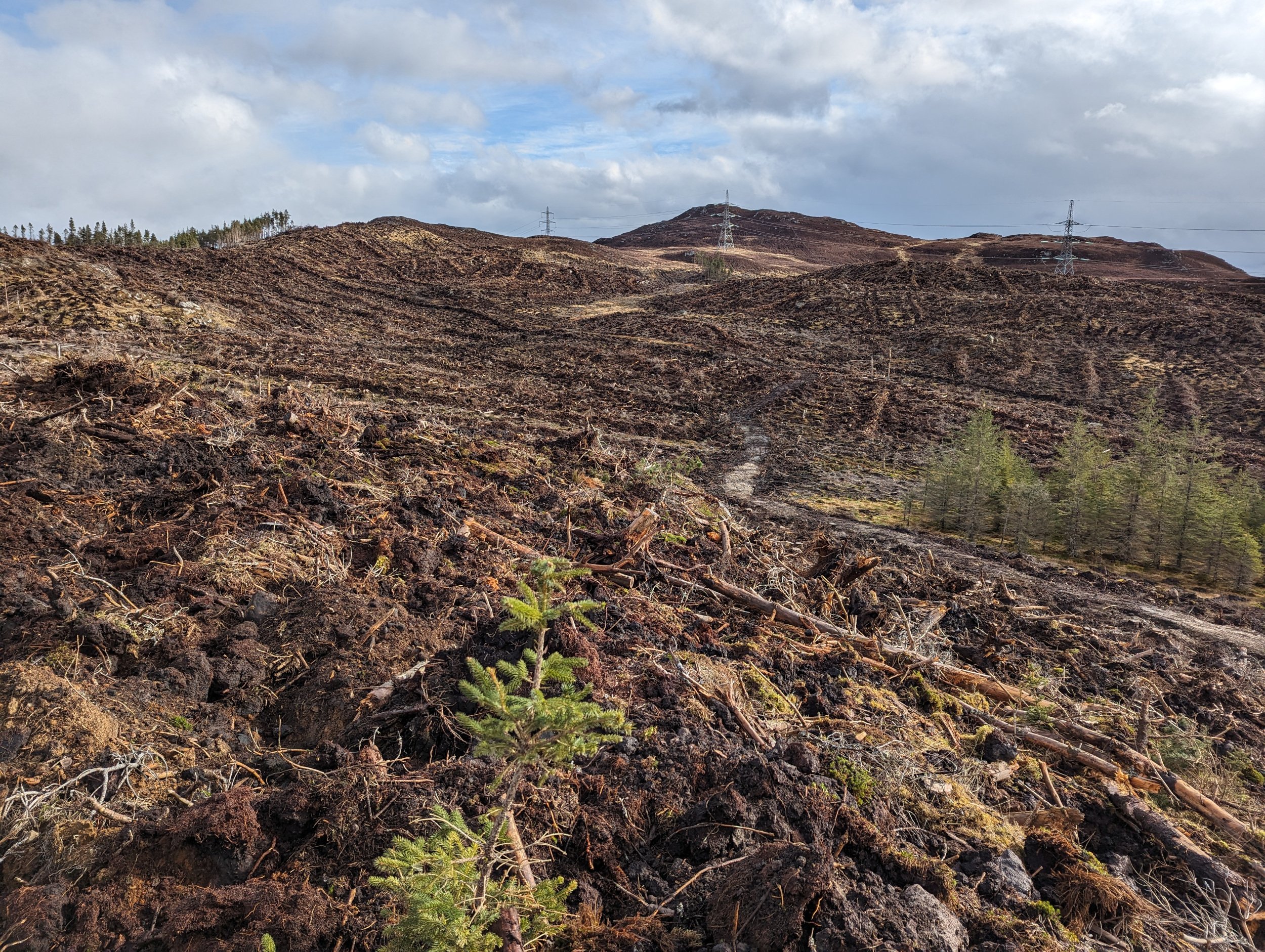
Site ready for replanting
This is a picture of a freshly-cultivated restock site.
In other words, a forest that was previously clearfelled and has now been prepared for replanting.
The particular cultivation method chosen here is ‘excavator mounds’, where a tracked excavator uses its bucket to create a raised planting position for each tree. It is a common approach with several benefits for the planted tree. It also makes the replanting work easier, particularly if woody debris leftover from the previous felling works is tidied-up while the cultivation machinery is on site.
Although this particular forest is being restocked with conifers for timber production, the composition won’t be the same as the previous rotation. Instead, there a greater proportion of the land will be stocked with native broadleaves and will not be managed for timber production. Furthermore, the new timber crop will be held-back further from watercourses than was the case previously, and also kept away from soft and peaty ground that probably shouldn’t have been planted last time around.
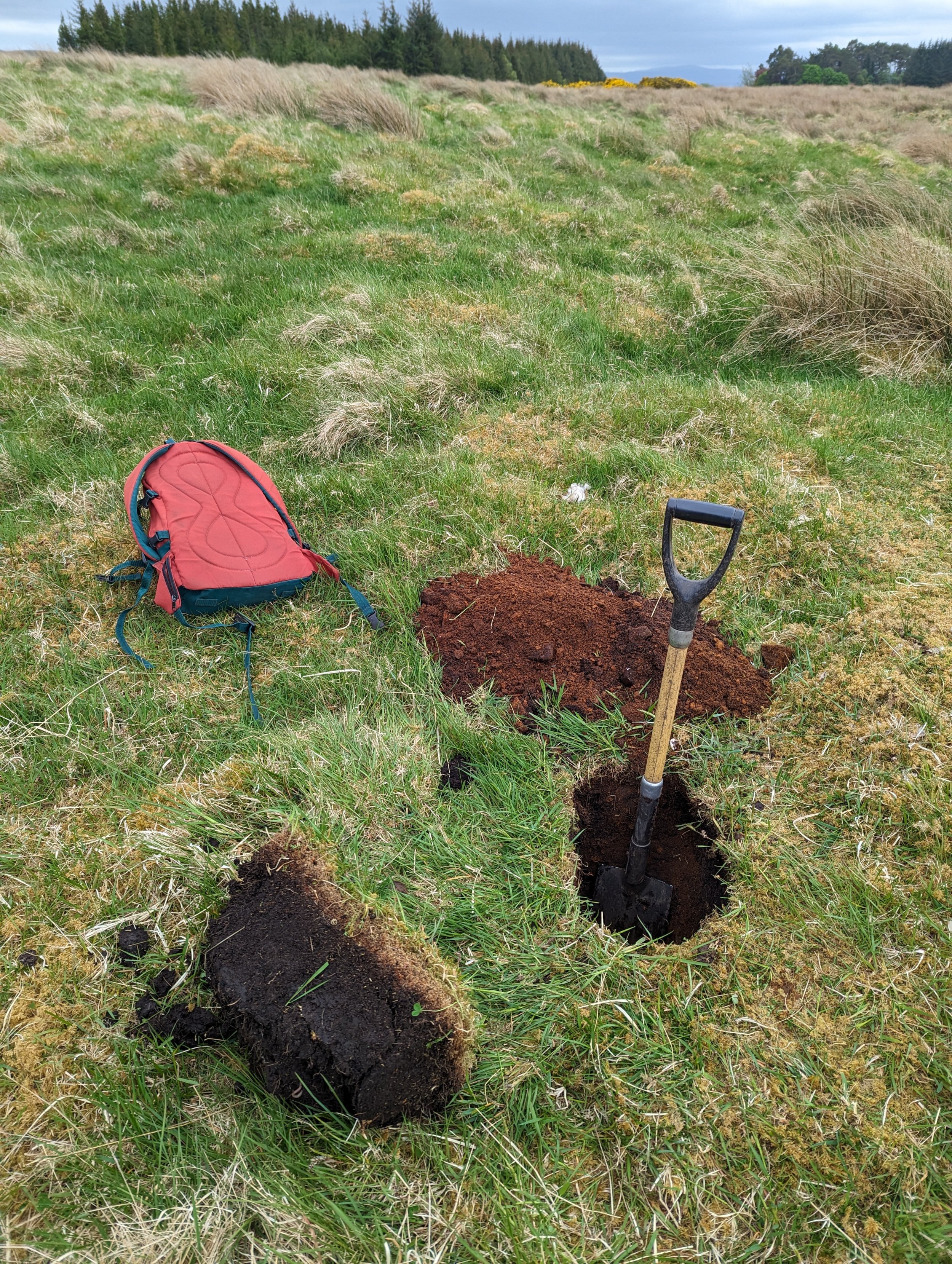
Digging soil pits
Nine times out of ten, one can quite readily determine whether land is suitable for planting trees within a short time of arriving at a new project area. Here, a quick walkover of the site is all that is required.
An exception is where the ground is peaty, soft or otherwise marginal, as the prevailing ground cover does not always provide the usual strong indications of growing conditions underfoot.
The site in the picture was clearly in the ‘plantable’ camp, but I dug some soil pits anyway to see what the conditions were like underneath the grassy sward of this area of improved grazing.
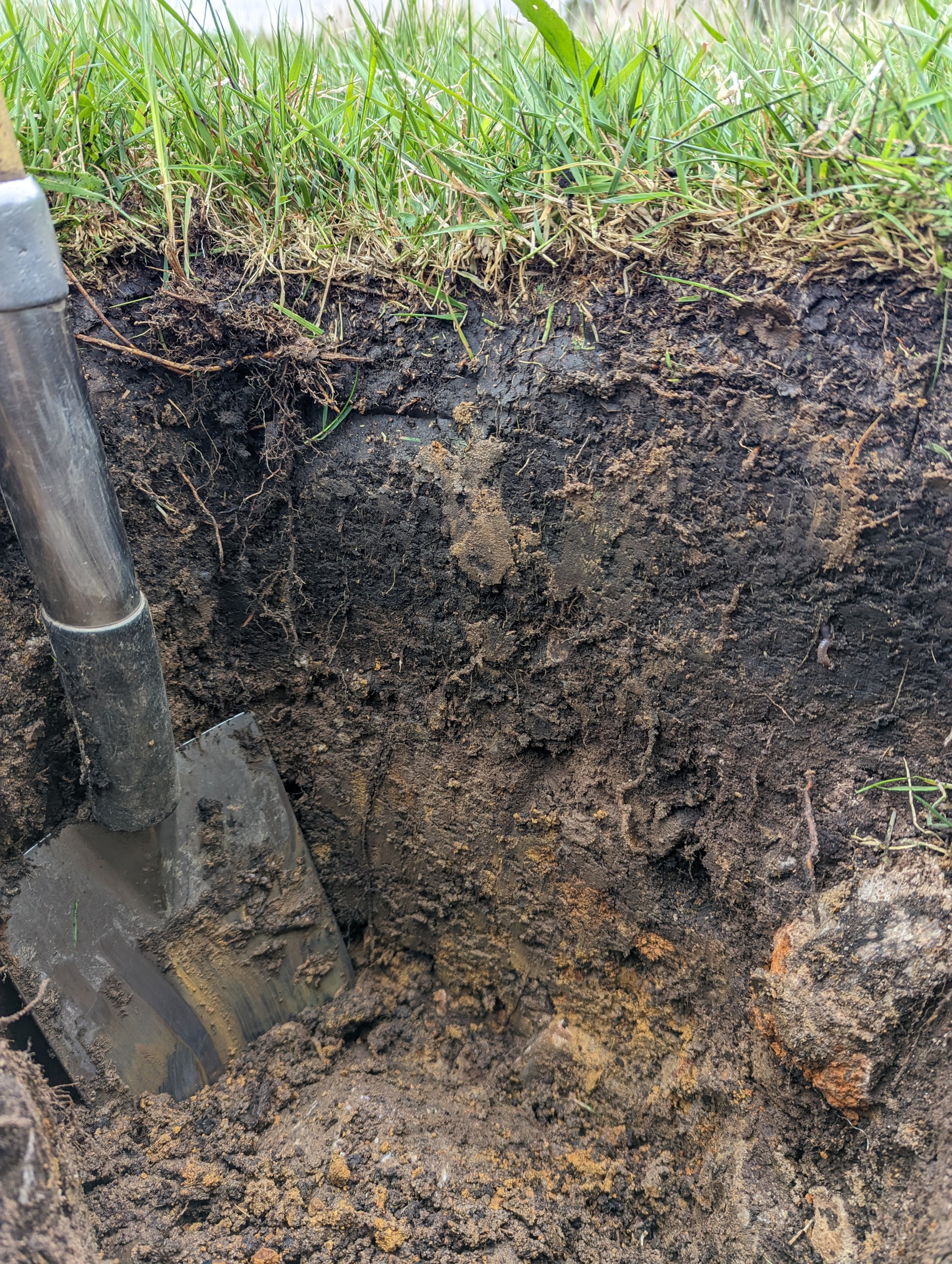
Soil pit
This picture shows a soil pit that was dug when assessing the potential of a site for grant-assisted woodland creation.
The owner had been keeping a small number of sheep on the ground and was looking to put the land to other use after deciding to reduce the size of the herd.
Evidently plantable just from walking around the field, the soil pit revealed a very typical North Highland soil: a peaty ground water gley. This would be fine for the typical native species of this area (birch, willow, rowan etc) - as well as a few pine on the occasional well drained knoll.
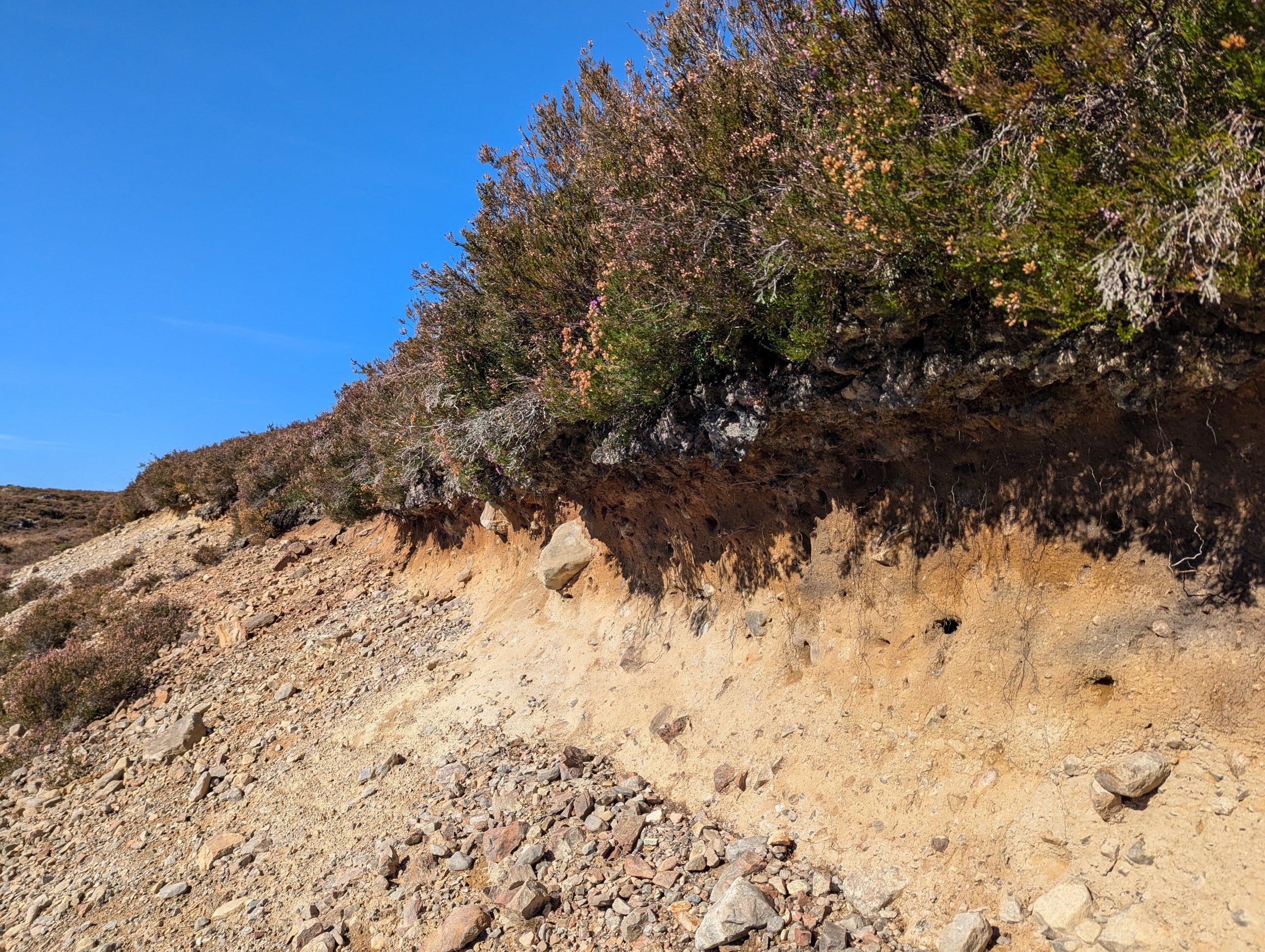
Pine territory
An eroded bank beside an estate track (not visible) shows a typical peaty podsol complete with a covering of Ling heather (Calluna vulgaris). This is a south-facing, well-drained, and ericaceous environment - great for planting Scots pine (Pinus sylvestris).
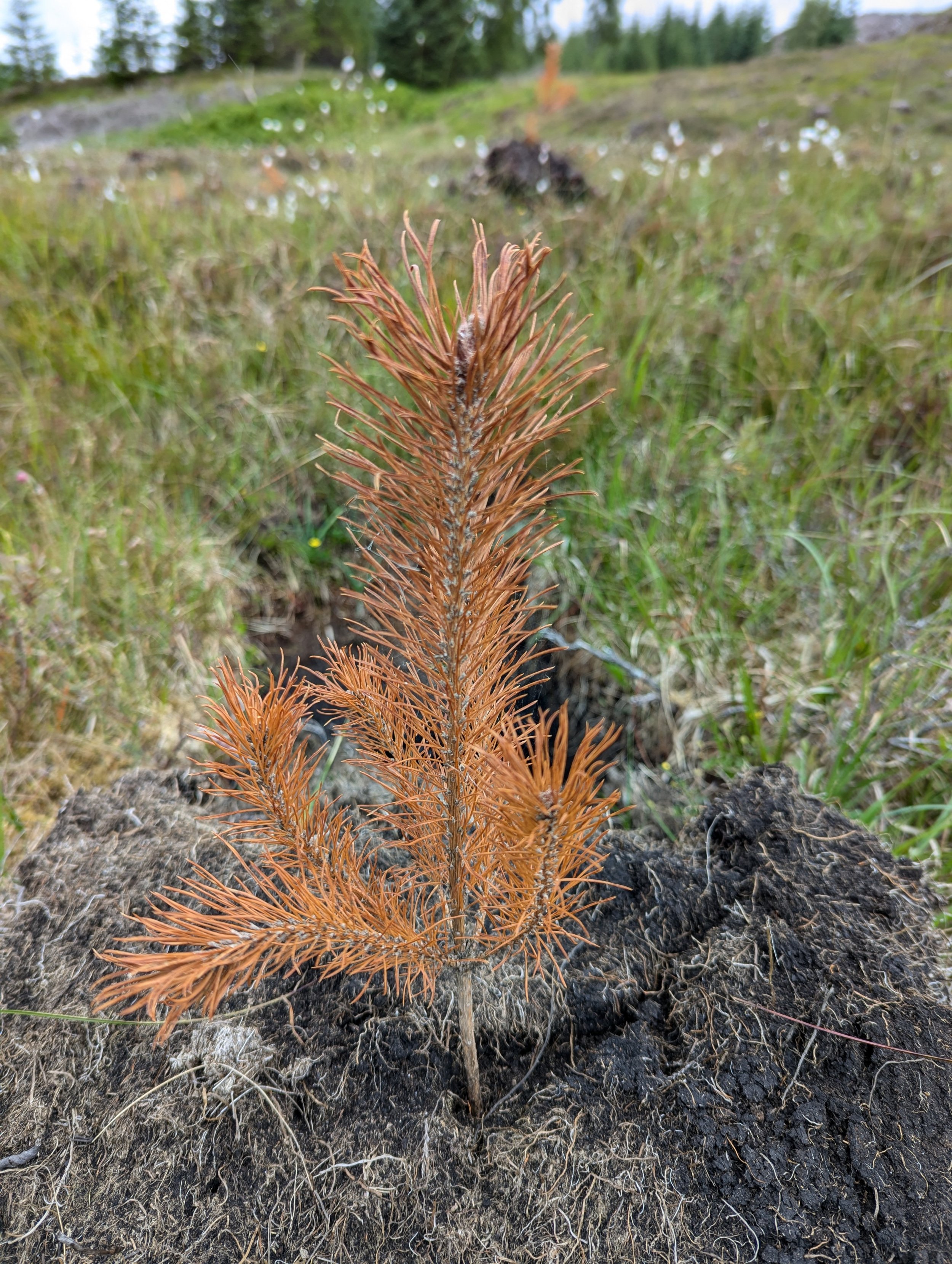
Stressed Scots pine
The Scots pine (Pinus sylvestris) in this native woodland planting scheme looked great for several weeks after planting in the spring, after which they turned brown almost overnight.
They may look completely dead but, some eight months later, most of the needles have now recovered and returned to being green, much to my relief. Even most of the trees that went on to drop all their needles are still alive, despite appearing at present to be completely dead.
How could I tell? Well, I used my thumbnail to scrape off a little bark low down on the stem, revealing the still-live cambium underneath.
Fingers-crossed, they should green-up in the coming spring.
As to what caused the problem? I am not completely sure but I think it was basic transplant shock mixed with a period of prolonged and unseasonal stiff, cool, northerly breeze that occurred in the summer following planting. Maybe this had a dessicating effect on the young trees at a time when their roots had not yet had a chance to establish fully.

Yours truly
A quick selfie, taken when planning the restocking of a felled woodland in Angus.
I am carrying two essential pieces of kit:
1. A hat to keep the damn flies away (yes, it is not just a fashion statement).
2. Safety reading glasses so I can see what I am recording on the map on my phone (I daren’t take my proper reading glasses onto a rough-and-tumble restock site).
The t-shirt tells a simple story: it was an unusually warm day for the time of year!

Woodland creation planning during the late autumn
I was planning a woodland planting project for some hill land at the end of October and the weather was very fine for the time of year. The sun was setting and it was time to start the long walk back to the car.
Just at that moment, the sun caught the landscape in front of me and it lit up with the most amazing browns and oranges. I took several pictures with my phone camera and stitched them together to form this montage.
Sadly, much of the detail has been lost in this image, as I had to re-scale is severely to upload it here. Still, it gives a good idea of what it was like to stand in that landscape during that brief passing moment.

Vole damage to holly
Voles are a pain. Where rank grasses provide them with cover from predation, large numbers can appear in a planting scheme and wreak great harm to even well-established trees.
Usually, they eat bark low down on the stem, and in the process girdle and kill a tree (or create a wound that allows ingress by pathogens and disease). In the case of this photo, the vole has bitten the stem higher-up and completely separated the main shoot.
I first thought it was a hare, as this is typical of the damage they do, but the enclosure was tiny and well-fenced with a rabbit net. Also, the damage appeared alongside typical vole damage on the same tree and throughout the stand.
In the case of this project, I thought at the time of planting that the cost of adding protection against voles to each tree was not justified, but soon changed my mind on seeing this. Vole guards were installed within a few days and the young native woodland saved from further harm.
This just goes to show that woodlands need to be monitored, especially when young and vulnerable to mammal damage. One shouldn’t simply plant them and walk away.























































